The post Electric Scooters for Beginners: Everything You Need to Know Before You Buy! appeared first on eRide Guides.
]]>In 2020, it’s not uncommon to see e-scooters existing with traditional, human-powered scooters, bicycles, or skateboards.
Dissecting what makes an e-scooter unique from its analog variety doesn’t have to be complicated. In fact, they operate in a similar way to scooters you’ve used as a child. With an added motor, battery, and throttle, you can exceed speeds of 20 mph (32 km/h) easily.
If you’re interested in picking up an electric scooter, this article will act as an introduction.
But first, we need to establish what an e-scooters is before discussing its laws, components, maintenance, and more.
What is an Electric Scooter?
First, let’s look at what makes an electric scooter unique from its traditional human-powered model. To put it plainly, and an electric scooter is a regular scooter with an electrical drive system.
This consists of a battery, motor, and a way to control it. E-scooters, unlike e-bikes, do not have drivetrains because there are no pedals to move the mechanism.
The SmartKick X8 has all the components of a traditional e-scooter:
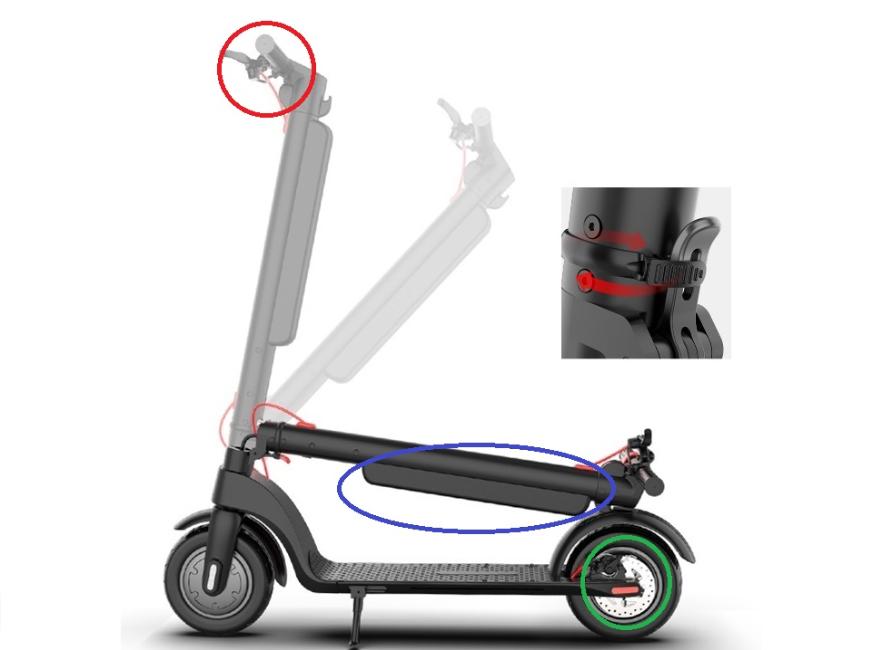
Photo Courtesy: Kat Dent/Smart Wheel
- Blue Circle: The battery that powers the motor sits on the stem.
- Red Circle: The throttle, which controls the power, is similar to a motorcycle handle.
- Green Circle: Mid-drive motor helps to propel the e-bike forward. Some e-scooters have motors in both wheels, while others have it in one like the scooter pictured.
These three critical components set the e-scooter apart from the human-powered scooter. Once you remove these components, the scooter becomes analog and must be pushed by your legs off of the ground.
What is the Difference Between an E-Scooter and a Motorcycle?
Although there are many similarities between an electric scooter and a motorcycle, they are entirely different from one another. The most significant difference is what powers the motorcycle.
Typically, motorcycles use gas because this fuel offers an unlimited range. Motorcycles can also keep up with highway traffic, and have room for a passenger.
As a disadvantage, motorcycles are more expensive, have loud motors, and are costly to maintain. Motorcycles take up a significant amount of space, as well.
E-scooters cost much less than motorcycles, even when compared to the initial price of the purchase, maintenance, and an expensive battery or motor replacement.
E-scooters are quiet and often fold so small and compact that they can fit in a backpack. You will miss out on the motorcycles’ cool’ factor because scooters are often associated with children’s toys.
If you’re on the market for a lightweight, foldable and compact mode of transportation with no rules or regulations, an e-scooter is the perfect vehicle for you. However, if you want to go faster, drive long distances, and have better visibility and suspension, a motorcycle will suit your needs.
What is the Difference Between an E-Scooter and a Moped?
Electric scooters are often compared to mopeds because of their similar (but bigger) design. Mopeds are gas or electric scooters with a platform for the user’s feet and a step-through base. Some are so big that they are often classified as “power-assisted bicycles” or motorcycles.
Despite how similar they are, mopeds and e-scooter have a few differences that set them apart. First, mopeds are more prominent and clunkier and must be operated on roads or European style wide sidewalks. Mopeds also require a driver’s license, registration, and insurance in most US states, whereas the e-scooter doesn’t.
In the United States, mopeds are made too big and broad to fit on the sidewalks (although some still try to – mopeds aren’t really regulated). E-scooters can function adequately on either the sidewalk or road as long as they’re fast enough to keep up with traffic.
Mopeds and e-scooters can’t ride anywhere but in the city, and both aren’t capable of riding up a mountain with the motor alone. However, an e-scooter is still capable of being carried up a mountain or kicked up if necessary.
How do E-Scooters Work?
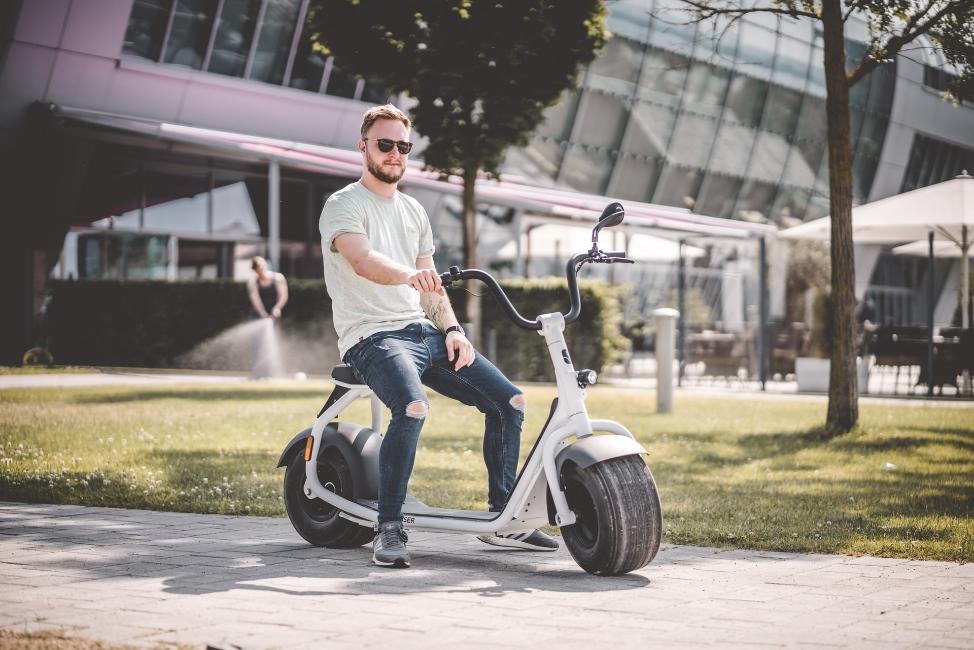
Photo Courtesy: Kumpan Electric/Unsplash
Mid-Drive
The electric mid-drive motor in an e-scooter creates an effortless riding experience fro the user. Although mid-drive motors are standard, hub motors are also found in e-scooters, although they don’t perform as well. Mid-drive motors take advantage of the guards to drive the crank and amplify the scooter’s powers.
On an e-scooter, the motor is located in one or more of the wheels, depending on the model. Keeping the motor close to the ground improves the center of gravity, which distributes the weight evenly throughout the scooter.
Battery
Electric scooter battery packs are made up of multiple individual cells that are assembled together. They store the energy that is consumed by the mid-drive or hub motor and other accessories like the lights.
Lithium-ion battery cells are the most common, although some kids’ models will use lead-acid batteries.
Batteries are rated in watt-hours (Wh) to measure capacity, and Wh is an essential factor in determining range. The typical scooter will range from 250-750 watt-hours, which could have a range of 20 mph (32 km/h), 25 mph (40.23 km/h), or 28 mph (45 km/h).
Throttle
Throttles are standard in most electric vehicles, including e-bikes and motorcycles, and they serve the same purpose. When the user turns the accelerator, the motor kicks in and lets you control the speed.
When you turn the throttle forward, the e-scooter will start to drive. The speed of the scooter is determined by how far forward the user turns the throttle.
Along with the accelerator, the brakes, power buttons, speed, and setting displays are also located in various places along the handlebars. Most portable e-scooters have folding handlebars as well, which can help with storage.
Not all e-scooters are made the same, but they all have these 3 components. Most electric scooters came with suspension, brakes, and lights.
How do you Ride an E-Scooter?
Electric scooters operate similarly to many electric vehicles (bikes or skateboards) in that they add a motor to assist propulsion. To ride an electric scooter, simply put your feet on the deck and pull the throttle forward.
Some electric scooters are seated. These are mostly for adults who prefer to make longer rides more comfortable. If your e-scooter doesn’t come with a seat, many can be fitted for one and are sold as a separate accessory.
If the motor runs out, you can push the scooter with your legs on the ground like an analog scooter. Since most batteries are small and detachable, it’s easy to recharge your battery within a few hours – so this is unlikely to occur.
Most e-scooters have either option (to use the throttle or kick manually). This is perfect for office workers who want to arrive at the job without sweating through their clothes. At the same time, an office worker can fold their e-scooter into a backpack or under their desk for easy storage.
Common Features of an E-Scooter

Photo Courtesy: Kenny Luo/Unsplash
Besides the battery, motor, and throttle, many other features come with the typical e-scooter.
Folding
Most electric scooters are able to fold completely in half so you can store them securely in your car, within your home, or on public transport.
If you often take detours in a subway or on an Uber, or you live in a bachelor or small apartment – pick a folding scooter. Folding e-scooters are often lighter, but it’s rare to find a scooter that doesn’t fold, anyway.
Braking System
A quality braking system, such as disc brakes, is essential to stay safe and in control while riding. Brakes can either be electronic or manual, where electric relies on the motor and mechanical relies on a physical mechanism.
Mechanical brakes offer a stronger system, but often e-scooters will use both in case one fails.
Controller
A speed controller sends power to the motor based on individual accelerator input. The controller receives inputs from the accelerator and brake controls and translates this current to the motor. Controllers are rated based on voltage and current to regulate, and they are responsible for most of the power that the e-scooter uses.
Deck
Similar to a skateboard deck, the deck on an e-scooter is the place where yous stand while riding. Rubberized nubs will line the deck for better traction. Some kick scooters will have a wider space for your feet, but a common deck size is usually 14″ by 5″ inches and gives you a few inches for ground clearance.
Stem
The stem is the tube that connects the metal casing to the handlebars. The folding mechanism is usually located on the stem for easy carrying and storage. Before purchasing a scooter, shake the stem back and forth to make sure it doesn’t collapse while riding.
It’s possible for the stem to wobble if the folding mechanism is poorly installed.
Electronic Panel
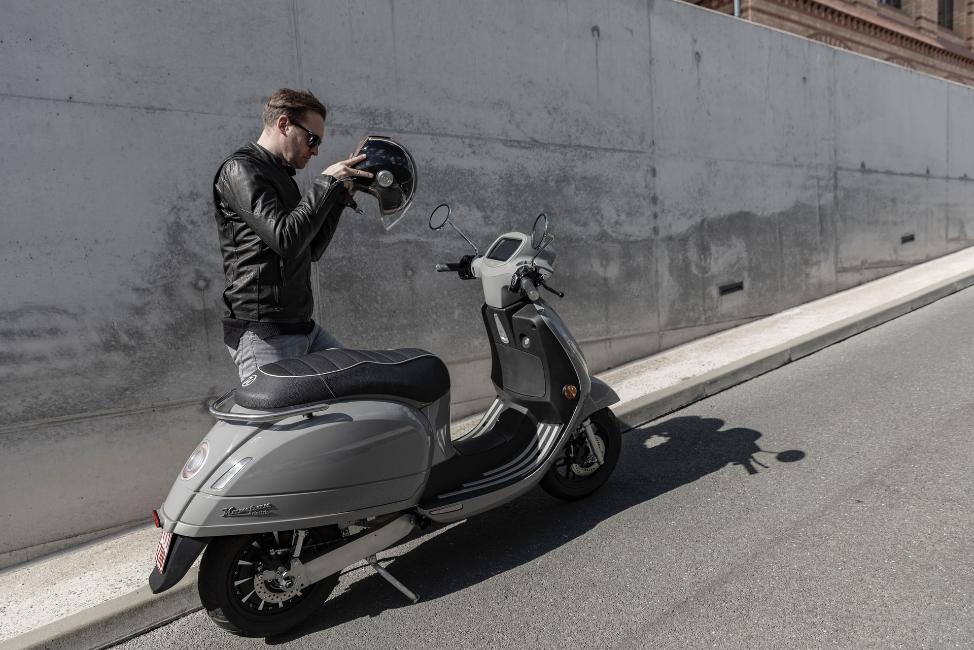
Photo Courtesy: Kumpan Electric/Unsplash
It’s common for an electric scooter to have a panel display, even though it isn’t necessary for the full experience. Electronic panels will display headlights, distance, power status, speed, PAS grades, and error messages.
A battery level display, included in most electric panels, is beneficial on short-range scooters that could run out of charge quickly.
Range
All e-scooters have a set range based on the batteries wattage. The range depends on the type of riding you’re doing (up a slight hill or city riding), so it’s difficult to put a proper range length as a selling point.
Most manufacturers assume you’ll ride on a flat sidewalk because e-scooters aren’t meant for uphill or mountain riding.
To calculate the watt hours (range) of a battery pack, multiply the voltage by amp hours. A 36-volt 10-Ah battery pack has 360-watt hours (36 X 10 = 360). Each mile costs 20-watt hours on average. Therefore, a 360-watt hour pack will get you 18 miles on one charge.
Suspension
May electric scoots have no suspension, but some expensive models will have coil-over-hydraulic suspension. There are three main suspension systems in an e-scooter: hydraulic, spring, and air piston.
The best suspensions will have a combination of sping and piston, but most scooters will us large pneumatic tires instead.
Tires
Tires help with traction and have internal braking mechanisms that activate in case of an emergency. Airless tires require no air maintenance, but pneumatic tires are better for their traction, ride quality, range, and performance.
If you have purchased a scooter without a decent suspension system, always opt for pneumatic tires.
Common Accessories for an E-Scooter
If you’re thinking about adding some accessories to your e-scooter, consider these items that can improve your safety while also helping you stand out from the crowd.
- Helmet: Safety is no joke – you could be maimed or killed from riding an electric scooter. Since e-scooters exceed 20 mph (32.19 km/h), it’s essential to wear a DOT-approved motorcycle helmet just increase of an accident.
- Side Mirrors: Unless you’ve purchased a $1000 e-scooter, they won’t come with mirrors even though they’re essential for your safety. You can equip a set of mirrors on your handlebars to increase your visibility.
- Lights: Don’t ride at night if you don’t have lights attached to the front and back of your scooter. If your e-scooter comes with front lights, equipt taillights so vehicles can see you in an alleyway or on a dark country road.
- Basket: Although e-scooters are often small, you can equip a deep basket that runs the length of the stem for groceries. Adding a basket helps to remove the likelihood of your back getting sweaty if you wear a backpack during commutes.
We also encourage you to get grips for your handlebars for a more comfortable riding experience. An extra seat may also be ideal for you if you plan on taking long trips. Always buy scooter tools for standard repair and maintenance jobs.
Growing Popularity of E-Scooters

Photo Courtesy: Nick Belanger/Unsplash
According to the Global E-Scooter Market projections for 2020-2024, the growth rate is expected to increase by 5.94% each year. On average, the e-scooter market is expected to grow by 2,138.50 thousand units in the next 4 years.
This is attributed to the increase in pollution and traffic congestion that is driving consumers to choose electric transportation.
The development of high-performance e-scooters is one of the reasons why market trends are seeing a growth in the market.
The decline in battery prices, increasing awareness of the technology, and the low operating cost make e-scooters affordable to many Americans, and many large retailers like Suzuki Motor are taking notice of this trend.
A senior analyst at Technavio stated: “Factors such as the emergence of connected e-scooters and established two-wheeler OEMs venturing into global electric two-wheeler market will have a significant impact on the growth of the e-scooter market value during the forecast period,”
Technavio, a global technology research and advisory company, researches emerging marketing trends. They assume that e-scooters will be on the rise indefinitely.
Laws and Regulations
E-scooters aren’t as regulated as other electric vehicles (like the e-bike), but in general, they are considered illegal in all US states. Most jurisdictions regulate them like bicycles, as they can be ridden on the street or bike lanes.
Since there are very few regulations associated with e-scooters, it’s better to review individual state laws before operating. You will not need a license or any special insurance to ride an e-scooter, although coverage is available if needed. Be sure to follow and obey all traffic laws, like stopping at a red light or turning left on a green light.
Speed and Kicking
The speed of an e-scooter depends mostly on price rather than other factors such as Class on an e-bike. Most e-scooters will range from 20 mph (32.19 km/h) to 28 mph (45 km/h). Anything faster isn’t considered illegal because e-scooters aren’t as regulated.
| Battery + Motor (Flat Terrain 165 lbs Male) | Max Speed | Average E-Scooter Cost | Average Charge Time |
| 250w | 20 mph (32.19 km/h) | $500 – $1000 | 20 minutes |
| 500w | 25 mph (40.23 km/h) | $750 – $1250 | 40 minutes |
| 750w | 28 mph (45 km/h) | $750 – $1500 | 60 minutes |
| 1000w | 35 mph (56.32 km/h) | $1000 – $1500 | 80 minutes |
| 1500w | 40 mph (64 km/h) | $1500 – $2000+ | 120 minutes |
E-scooters have the option of turning into kick scooters, but they won’t provide any extra speed. In fact, they will slow down your e-scooter and/or case the braking mechanism to kick in for safety reasons. It’s better just to use the throttle.
Safety Tips
E-scooters provide a great way to get around the city. Although they are considered relatively safe, e-scooters require attention to ensure your commute doesn’t become dangerous. Many electric scooter safety tips apply to traditional scooters, bicycles, and other motorized vehicles.
- Wear A Proper Helmet
- Use Both the Tailights and Headlights
- Use a Bell or Horn to Warn Others
- Never Ride Against Traffic
- Avoid Sidewalks if Possible
- Keep Pneumatic Tires From Deflating
- Use Defensive Driving Techniques
- Install and Use Your Mirrors
Even though scooters aren’t regulated or require a license to operate, it’s never okay to drive drunk. It’s possible to get seriously injured if you aren’t aware of your actions. Instead, fold your e-scooter, place it in an Uber, or walk home.
Insurance
Property insurance (renter or homeowner condo insurance) usually includes liability protection. This means that if someone gets hurt, or has their property damaged or destroyed in an accident, that liability insurance should help cover your expenses.
This can also include damages defense costs settlement and judgment awards.
You must report any damage you see on your e-scooter to the insurance company, as the manufacture will usually cover general wear and tear. However, if the cost goes beyond the damage of your scooter, you likely won’t be covered by insurance.
Most insurance won’t cover medical expenses, but your health care provider will likely supplement that cost. Liability coverage in your home and auto insurance is tailored towards injuries to others, so insurance won’t cover you in this situation.
Although insurance does exist, it’s a lot more prevalent in Europe and Canada than it is in the United States. You may have to get bicycle insurance that includes other motor vehicles. To see what in-depth coverage looks like, visit this insurance company based out of Alberta, Canada.
Average Lifespan
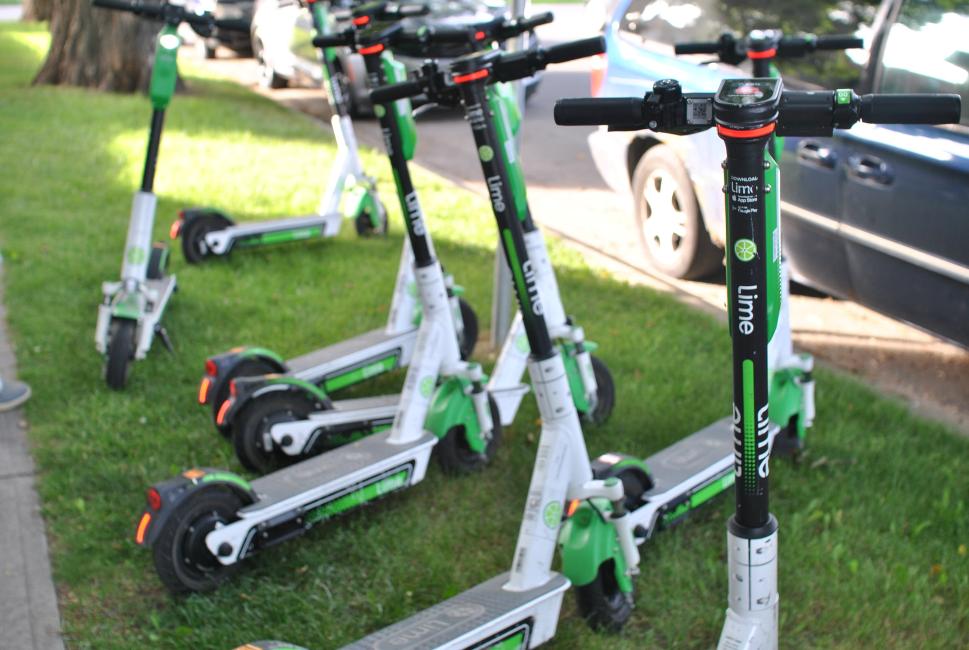
Photo Courtesy: Zera Li/Unsplash
Privety-owned e-scooters with proper maintenance and care will last at least 2-3 years, and likely much longer than that. Rideshare electric scooters will only last 1-5 months, but that is likely due to the mistreatment of the device itself.
If you treat your e-scooter correctly, you could see 7 years or longer.
Privately-owned e-scooters aren’t often dumped, so people likely continue to fix them for as long as possible. Individual parts that tend to break are the battery, front and rear lights, tires, and the rear fender.
If you focus your time on maintaining these parts, you’ll likely have an e-scooter that lasts a very long time.
Maintenance
Schedule A Weekly Cleaning: Keep your e-scooter clean as often as possible to dirt, debris, and dust don’t make their way into the engine. Never use a pressurized hose or stream of water because it could expose liquid into the electrical system.
Lubrication: You should lube the rolling mechanism every 3 months. The specific timeframe for lubing and greasing depends on your riding conditions. The more water and dirt your e-scooter is exposed to, the sooner you’ll need to grease it.
Tire Pressure: Whether your e-scooter comes with air-filled or solid rubber tires, you need to ensure there are no cuts or scrapes on the surface. Flat tires are common, so pump them full of air every week to keep a smooth ride long-term.
Check the Bolts: Be sure to tighten the nuts and bolts every two months or so. Use your fingers to see how tight or loose the nuts are, and if they come apart with your own strength, it’s crucial to tight them immediately for your safety.
Battery: Lithium-ion batteries are pretty durable, so there isn’t a lot you need to do to maintain them. Do your best to keep water out of them and store them at room temperature to ensure they function correctly.
Brakes: Before you ride your e-scooter, it’s important to pump the brakes to ensure they function. Otherwise, you could end up in a serious accident. If you notice they aren’t working properly, brake pads are cheap and easy to replace.
Storage Tips: Keep your e-scooter indoors wherever possible. E-scooters don’t do well in high temperatures or water, but they can handle a small drizzle or occasional direct sunlight. Always remove the battery and motor during prolonged storage.
Are you an e-scooter enthusiast?
Are you interested in many other articles, like this one, that gives in-depth information about different e-scooters?
Visit our website for more information on the best electric bikes and scooters that can make your commute more stylish and fun.
Before you go, leave a comment on your favorite e-scooter maintenance tips.
Be sure to read one of our other articles about the history of bicycles and e-bikes while you’re at it!
The post Electric Scooters for Beginners: Everything You Need to Know Before You Buy! appeared first on eRide Guides.
]]>The post Should I Buy an Electric Bike or an Electric Scooter? appeared first on eRide Guides.
]]>After all, they both function the same way, have two wheels, and have features that resemble their pedelec scooter and bike counterparts.
The major differences between an e-bike and e-scooter are the laws that govern their use. However, there are still minor differences between weight, speed, price, range, safety, durability, and overall look. You may even want both electric vehicles for various purposes.
To clarify, in this article, ‘scooter’ won’t refer to the four-wheeled variety that’s used by people with mobility issues nor the push wheel kind.
E-scooters are often interchangeable with mopeds because they are both electric-powered vehicles without pedals.
In this article, we will engage in the analysis of both e-bikes and e-scooters and compare which is better and which will attend to your daily needs.
Before we do that, let’s make a distinction between human-powered bikes and scooters and the definition of electric vehicles.
10 Reasons to Buy an Electric Bike or E-Scooter
If you’re thinking of joining in on the electric transport craze, consider these reasons to pick one up before getting into the more important details.
- It doesn’t take a lot of practice to ride an electric vehicle safely.
- You can get a great cardio workout with an electric bike.
- Both the e-scooter and e-bike are more affordable than a car or motorcycle.
- E-bikes and e-scooters enable seniors and the physically disabled a method of travel.
- Motors will kick in on an e-bike if you’re too tired to pedal.
- They can reach high speeds, although higher speed models may require licenses or road use.
- Capable of riding in bad weather conditions or on slight inclines with motor support.
- Requires little maintenance in comparison to a motorcycle or car.
- Both e-bikes and e-scooters allow you to sit or stand.
- E-vehicles use simple throttle technology to power and change its speed.
Why Electric Vehicles are Perfect for Cities
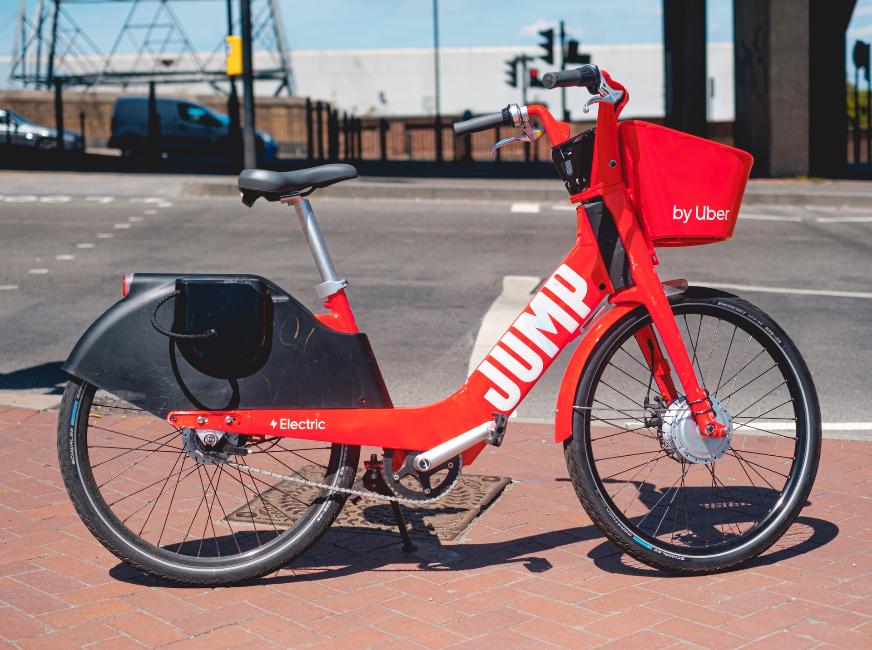
Photo Courtesy: Ehimetalor Akhere Unuabona/Unsplash
Depending on where you live, purchasing a car is out of reach or impractical. If you live in LA and drive to work, you’re familiar with the slow-moving highway traffic and frequent accidents that make commuting even slower.
On top of that, you need to spend time looking for parking in a busy area. Often, it’s more cost-effective and less stressful to take a bus or walk because you save money on gas and don’t need to find a space to park.
Even though public transport solves most of these problems, busses run on their own schedule, only drop you off at key locations, and are often crowded and unsanitary. Now, you have no control over your trip, and it may take a large chunk of time out of your day to catch the bus.
An e-bike or e-scooter solves all of your problems, and in many cases, they are better for travel than trains, buses, or cars. A folding scooter or bike doesn’t even need a parking spot – you can just bring it with you while you shop or place it under your desk at work.
Can’t a Human Powered Bike or Scooter do the Same Thing?
Absolutely. A human-powered scooter or bike can take you where you need to go and are a practical means of transportation. They also give you a cost-effective method of exercise and are an eco-friendly option that most people can use daily.
However, many people don’t live close to their work, or they don’t have the physical fitness or capability to bike for miles a day. Even for those who are capable of biking long-distances, you will almost always arrive a sweaty mess.
An electric bike or scooter is accessible for all ages, fitness levels, and physical capabilities because the motor provides additional support for longer or harder commutes. You won’t find yourself stranded if you can’t pedal or kick your analog vehicle long distances.
E-Bikes vs. E-Scooters
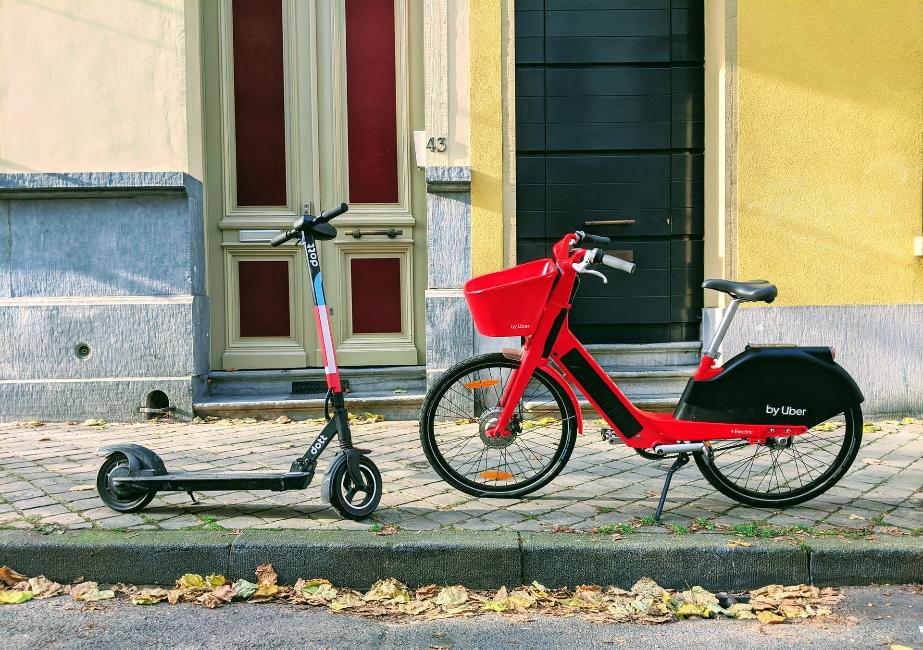
Photo Courtesy: Lucian Alexe/Unsplash
There is some confusion surrounding e-bikes and e-scooters. Even though both bikes are 2-wheeled, they feel different when you ride them, and their legal requirements, mileages, and benefits vary greatly.
Electric Bikes
Electric bikes are 2 wheeled bicycles that come outfitted with functional pedals – usually. Some e-bikes won’t come with pedals, but those are usually models that are small, less than $500, or aren’t fitted initially because they come at an added price.
Even though e-bikes look similar to human-powered bicycles, they have motors planted on the frame. Typical places to find the motor vary on model and manufacturer, but a rear hub motor, front hub motor, or center hub motor are common.
E-bikes will also have a battery to power the motor, a drive train to turn the power generated to propel the bike forward, and a throttle to manage and change speeds. Otherwise, an electric bike has the same parts and components as a regular bicycle.
Pedal assisted e-bikes give your bike an extra boost while pedaling, and some models require you to pedal to start the motor. While some e-bikes will need physical effort to maintain speeds, others will either make pedaling optional or will be 100% motor functionality.
Electric Scooters
Electric scooters are a two-wheeled vehicle that differs from a skateboard because it has handlebars. In comparison to an analog scooter, the e-scooter will have a motor and is self-propelled after the users’ initial kick-off from the pavement.
The powerful accumulator can help you overcome a more considerable distance than what may have been capable of a human-powered scooter. You also won’t have to push off the ground to keep momentum continuously – you just have to use the throttles on the handlebars to maintain speeds.
Some e-scooters will include a seat that makes them more similar to a moped than a scooter, but the seat can add extra comfort for anyone who doesn’t want to stand for long distances. E-scooters with seats are more expensive than standing versions.
Since e-scooters never come with pedals, there aren’t pedal-assisted scooters. If you want to go faster, you could kick on the ground – but you’ll probably hurt yourself. E-scooters aren’t for people who wish to exercise during their commute.
Legal Requirements
The United States has confusing laws when it comes to understanding what a street-legal electric scooter is. This is because the US federal law governing electric bikes also applies to electric scooters as well.
Electric Bikes
US2002 Federal Law states that an electric bike will become street legal if it has a top speed of less than 20 mph (32 km/h), and the motor power is below 750W. However, because most states don’t follow this law, or have implemented a Class system for bikes, this isn’t always true.
The chart below shows legal bike speeds (20 mph – 28 mph) and illegal speeds (35mph or higher). It’s possible to rig an e-bike to go faster than what’s listed on this chart, but it won’t be road legal.
| Battery + Motor (Flat Terrain 165 lbs Male) | Max Speed | Average E-Bike Cost | Average Charge Time |
| 250w | 20 mph (32.19 km/h) | $500 – $1000 | 20 minutes |
| 500w | 25 mph (40.23 km/h) | $750 – $1250 | 40 minutes |
| 750w | 28 mph (45 km/h) | $750 – $1500 | 60 minutes |
| 1000w | 35 mph (56.32 km/h) | $1000 – $1500 | 80 minutes |
| 1500w | 40 mph (64 km/h) | $1500 – $2000+ | 120 minutes |
The 3-Class System
Here is a breakdown on which e-bikes classify for Class 1, Class 2, and Class 3 under the legislation. Since 2014, the national bicycle advocacy group PeopleForBikes has helped over 30 states pass standardized regulations for e-bikes with the use of the 3-Class System.
- Class 1: Assists pedaling but not your throttle, these e-bikes are passive and are allowed to function on bike paths. Pedal-assist only (absolutely no throttle), and have a maximum assisted speed of 20 mph (32.19 km/h).
- Class 2: Known as low-speed throttle-assisted e-bikes. These e-bikes have motors that proper the cyclist without pedaling. The rider cannot exceed more than 20 mph (32.19 km/h) like Class 1, accept Class 2 e-bikes must be throttle-assisted.
- Class 3: Known as speed pedal-assisted electric bikes and provide assistance to the rider if they’re pedaling. Cannot have a throttle. Class 3 e-bikes can have a maximum assisted speed of 28 mph (45 km/h). However, the US only allows bikes on the road that have a maximum of 20 mph (32.19 km/h).
All e-bikes, no matter the Class, limit the motor’s power to 1 horsepower (750W). Be aware that the class system is specific to e-bikes, whereas e-scooters have their own system in place that is similar, but not the same.
Electric Scooters
In the United States, electric scooters are allowed on roads that lack bicycle lanes as long as they don’t exceed speed limits of 25 mph (40 km/h). Similar to e-bike regulations, this varies based on state. E-scooters are sometimes their own category but are usually treated as e-bikes.
California, for example, uses the classification of Personal Light Electric Vehicles and can ride on pavements, roads, and cycle lanes as long as you’re over the age of 16 and are wearing a helmet. However, in San Francisco, it’s illegal to leave your power scooter unattended.
E-scooters don’t require a license to operate, although some US states do require one if you want to operate an e-bike. Always check your local laws before operating either electric vehicles to ensure you aren’t breaking any state laws.
Overall, it’s easier to own an e-scooter because less licensing is needed to operate one, and you are less likely to break any laws. Just ensure that you wear a helmet with an e-scooter and follow traffic rules in your state to avoid a ticket.
Price Comparison
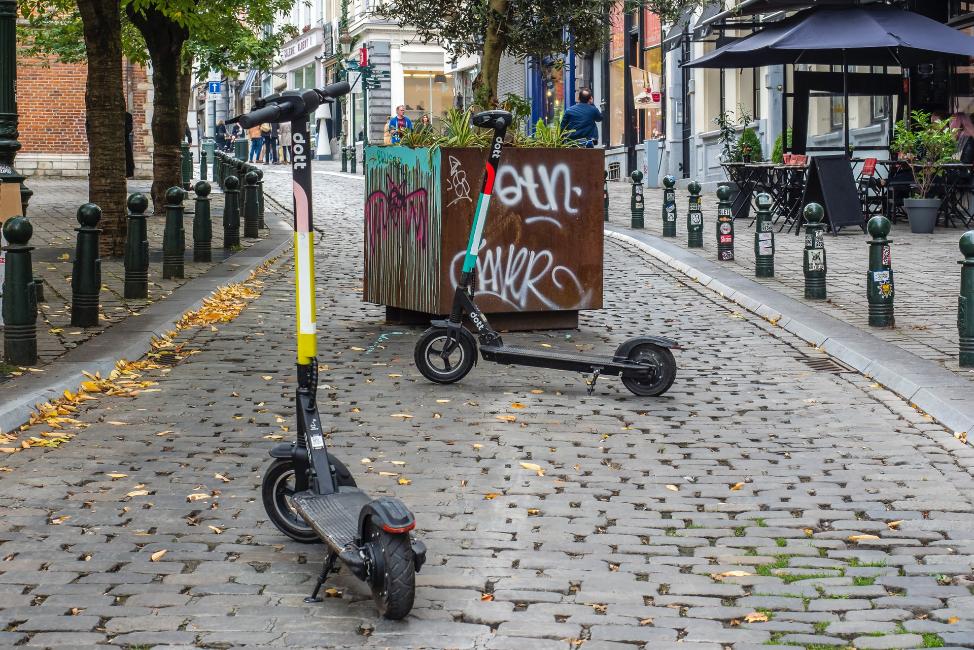
Photo Courtesy: Alexander Schimmeck/Unsplash
On average, e-bikes are more expensive than scooters on the initial purchase, but in general, electric-powered vehicles are cheaper than gas-powered ones. When compared, electric scooters and electric bikes generally have a lower running cost than gas-powered vehicles.
A 5 km (3 miles)ride will only cost you 5 cents in electricity, whereas gas can cost upwards to a dollar per 4km (2.5 miles). However, calculating the cost of the vehicle doesn’t just start and end when you buy the product. You also need to factor in the maintenance and quality of the e-vehicle.
Both the range of the prices for electric bikes can start low (less than or equal to $500), they can sky-rocket as their specifications increase. Due to the popularity of e-bikes, it’s likely the e-bikes will become cheaper as the parts become cheaper to produce.
Even though an e-scooter is cheaper initially, electric bikes are cheaper to maintain if you don’t have expertise in electric vehicles. Maintaining your e-bike is more convenient than e-scooters are because more mechanics know how to service their parts.
E-bikes have one significant value advantage: you can electrify most regular bikes. E-scooters don’t have conversion kits readily available, but e-bikes do. For example, a conversion kit like Swytch can quickly turn any human-powered bike into a motor-powered one.
In general, higher-priced e-bikes or e-scooters will provide a better range, higher speeds, and are made of higher quality material. Paying more for an e-vehicle also translates to lighter weights rather than a jump in raw power once pricing exceeds $1000.
Portability Comparison
Unless you have a scooter that’s as big as a moped, e-scooters are almost always more portable than e-bikes. Most scooters are tested to fit in a trunk or sedan and are allowed on public transportation and Ubers. E-bikes are often too big for most cars.
E-scooters are also lighter than e-bikes because there are fewer components on the scooter itself. A scooter is basically 2 long pieces of metal, 2 wheels, and 2 handles. An e-bike has more complicated machinery and is usually heavier and has a bulkier frame.
Few e-bikes weight less than 40 lbs (18 kg), and only a few expensive (over $1500) e-bikes will weigh less than 30 lbs (13 kg). More affordable models will run you higher than 60 lbs (27 kg). However, e-scooters average 30 to 50 lbs (13 kg to 22 kg).
These comparisons are not a hard and fast rule – some e-scooters and e-bikes are small enough to fit in suitcases. Overall, scooters are usually less expensive, smaller, and more portable, whereas e-bikes can be bulky, heavy, and may not always bend in half.
Range Comparison

Photo Courtesy: Galen Crout/Unsplash
E-bikes have better ranges than e-scooters – period. It’s rare to see an e-scooter go beyond 40 miles (64 km) on a single charge, but many e-bikes will go at least 70 to 120 miles (113 to 193 km). On top of that, e-bikes can go farther – at a lower price.
Unfortunately, once your e-scooter runs out of juice, you’ll need to kick the ground to get moving again. However, it’s harder to do so because the scooter is incredibly heavy. An e-bike has a pedal assist and constant momentum, which makes pedaling an e-bike effortless.
Still, if your battery does run out of the scooter, you can always call a cab because they can fit in the trunk. With an e-bike, you’ll have no choice but to power it yourself because most Ubers and taxis won’t let you store a bicycle in a car.
Exercise Comparison
If you want to use your mode of transportation as an exercise device – don’t pick an e-scooter. Sure, you can push the scooter along, but it won’t provide you the type of full-body exercise that a pedantic e-bike can.
Riding an e-bike gives you the option of a serious workout, and more often than not, e-bike riders get more exercise the cyclists. E-bike riders tend to make longer commutes, which usually involves pedaling to either get to the destination faster or because the option to exercise is already there.
Lugging a 70 lbs (31 kg) e-bike up a hill with the assist turned off will give you quite the workout and will undoubtedly activate your quadriceps. An e-scooter can’t do that; it would actually be safer and faster to walk up a hill while bench pressing a piece of metal.
Speed Comparison
Both the e-scooter and e-bike are capable of speeds faster than their human-powered equivalents. In the Legal Requirements section, we governed the regulations of e-bikes compared to e-scooters, where e-bikes are more regulated based on speeds.
In the US, e-bikes cannot exceed 20 mph (32 km/h) in most cases. Since US laws differ from state to state, it’s better to research each individual state before using an e-bike that may exceed 28 mph (45 km/h), which is the legal limit is some states.
E-scooter have mostly unenforced or ambivalent laws. You are unlikely to get stopped by the police for speeding on an e-scooter in a bike lane or on the road. It’s bizarre because it’s easy to buy or rig e-scooters to exceed 40 mph (64 km/h).
Technically, e-scooters can go faster because they’re legally allowed to. Plus, e-scooter are more compact, meaning you can either carry them around with you or in a backpack, which saves you time. Locking up your bike takes extra time and more security precautions.
Utility Comparison
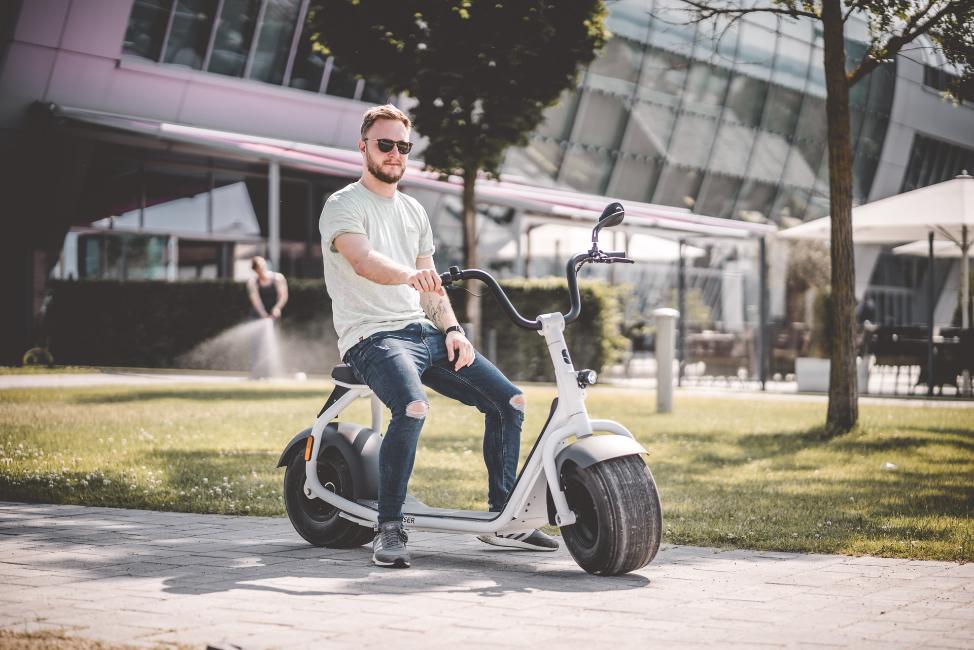
Photo Courtesy: Kumpan Electric/Unsplash
While e-scooters excel in portability, e-bikes are perfect for extra cargo and are capable of holding multiple add-ons. It’s possible to attach baskets on the front and back of cargo e-bikes for grocery trips or to haul your projects to and from work.
Even if your e-bike isn’t meant to hold cargo, you can equip your regular city or commuter e-bike with trailers, rockets, baskets or panniers. E-scooters simply don’t have the space or stability for a large amount of cargo or add-on accessories.
Safety Comparison
It’s difficult to compare safety on the e-scooter or e-bike because they’re only as safe as the operator is at handling them. Safety can vary tremendously based on the make, model, and type of electric vehicle you’re riding.
E-bikes have bigger wheels that can travel over potholes and debris without the fear of bouncing too high or off the seat. These tires can also navigate wet weather, and the heavier frames offer more stability. E-bikes are also more visible on the road.
An e-scooter, however, makes you more agile so you can quickly navigate around pedestrians or cars. You can hop off the scooter if necessary to avoid a severe accident, which is more challenging to do on an e-bike – especially with the motor or battery in the way.
On average, there are more accidents from e-scooter than there are from e-bikes, and it’s likely because of the lack of regulations. Still, e-scooters have larger tires and a better suspension, so day to day use is more comfortable and accessible than on an e-bike.
Another recent study shows that e-bikes have a distinct pattern of severe injuries that result in hospitalization. Overall, e-bikes result in fewer accidents, but the accidents are more severe, whereas e-scooter users are more likely to have accidents that aren’t life-threatening.
Always wear a helmet. Wearing a helmet can reduce many injuries, especially injuries involving the head, neck, and shoulders. If you happen to fly off your e-bike or e-scooter, you can save yourself from a severe concussion or brain injury.
Durability
E-bikes have more direct support if they have a flat tire, a bent spoke, or need general maintenance. E-scooters don’t have the same accessibility because they are less prevalent than e-bikes, so many mechanics aren’t knowledgable on e-scooter components.
To make matters worse, e-scooters aren’t as durable as e-bikes. E-bike manufacturers have the 200-year history of bicycle maintenance under their belt, as well as the decades of knowledge-based around servicing e-bike specific components.
If you want at least a 15-year relationship with your electric vehicle, opt for an e-bike. They’ll often last longer, have better parts, and maintenance is easier. If you own an e-scooter, you will need to learn a lot of maintenance tips yourself.
Are you an e-bike or an e-scooter enthusiast?
Are you interested in many other articles, like this one, that gives in-depth information about different e-bikes and e-scooters?
Visit our website for more information on the best electric bikes and scooters that can make your commute more stylish and fun.
Before you go, leave a comment on your preference – do you like e-bikes or e-scooters more?
Be sure to read one of our other articles about the history of bicycles and e-bikes while you’re at it!
The post Should I Buy an Electric Bike or an Electric Scooter? appeared first on eRide Guides.
]]>The post Which Electric Bike to Buy? Deciding on the Right e-Bike For You appeared first on eRide Guides.
]]>Or are you an electric bicycle enthusiast who is looking for their next ride? Maybe you made the mistake of buying prematurely on your first go around, and want to make a more informed choice?
No matter how new, confused, or seasoned you are when it comes to e-bikes, it’s essential to make an informed choice. With that said, many e-bikes fulfill specific purposes. In this article, we’ll be discussing how you can make the best decision possible.
When it comes to e-bike factors, some features will remain the same across types.
For example, the motor, battery, riding experience, durability, and safety will all come in play, no matter if you’re looking for a cruiser, off-roader, or a smaller foldable e-bike for an easier commute.
Always consider the best choice for yourself and your own needs. Don’t rely on the most expensive models, especially if they fail to keep your own criteria as a transportation device. It’s possible to get everything you need from one e-bike, even one that’s more cost-effective.
Let’s look at each type of electric bike you can buy, it’s unique features, and whether or not they provide advantages to you as a rider.
Cruiser E-Bikes

Photo Courtesy: Sol Electric
| Model Name | Weight | Range |
| Tower Beach Bum | 49 lbs (22 kg) | 45 miles (72 km) |
| Blix Sol | 57 lbs (25 kg) | 45 miles (72 km) |
| Magnum Low Rider | 60 lbs (27 kg) | 55 miles (89 km) |
A cruiser bike is designed for casual riding because their frame causes the rider to sit in a very comfortable, upright riding position on a large, comfortable seat. Cruisers often have ‘balloon’ tires with better shock absorption, yet the wheels tend not to have individual shocks.
Handlebars sit slightly more upright than other models, so your posture remains straight up instead of slanted or bent. Many cruisers don’t typically have more than one speed, but you can find a 3-speed version for a higher price.
On a traditional bicycle, cruisers have coaster brakes instead of handlebar brakes. Coaster brakes require you to pedal backward to stop. However, e-bike cruisers have brakes on the handlebars to properly activate the disc brakes.
If you’re looking for a model that can travel short-distances for errands and commuting, pick the cruiser as long as your route is flat. Although the 3-speed models can go up small hills, it’s better to get a mountain bike if you plan on riding on hilly commutes.
Cruisers are more massive than other models, are more fashionable than other e-bikes, and often come in a wide variety of colors. The focus here is comfort – not performance, so you won’t need to worry about the motor or battery too much. Pay more attention to the tires.
Mountain E-Bikes
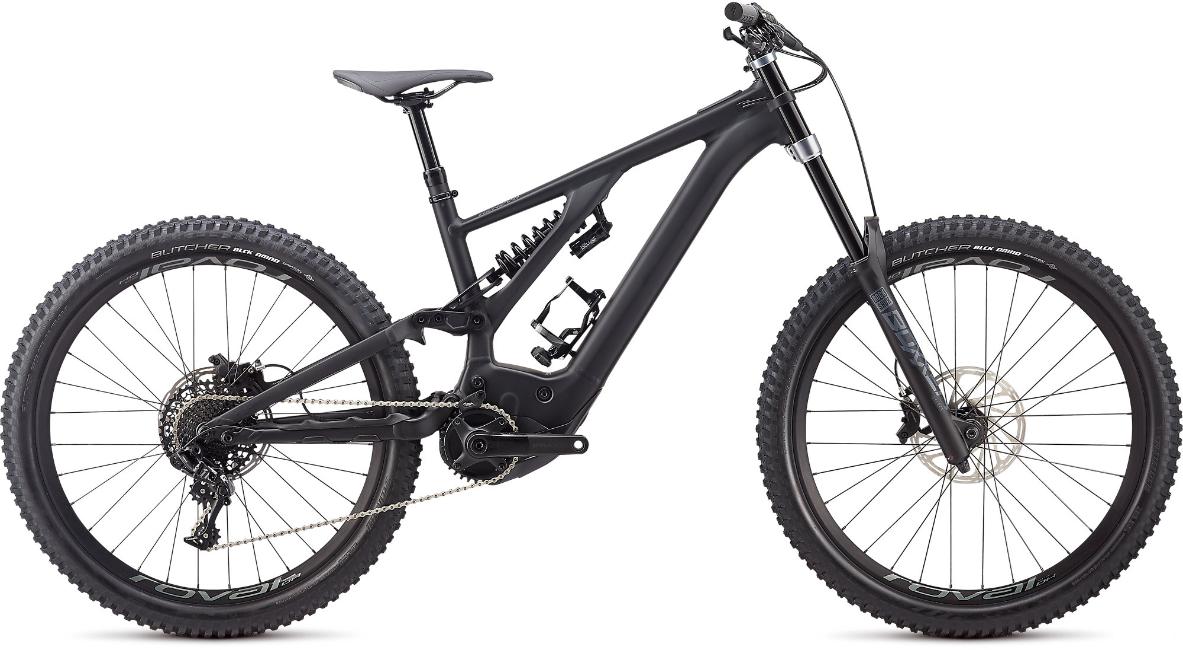
Photo Courtesy: Specialized Kenevo
| Model Name | Weight | Range |
| Specialized Kenevo Expert | 53 lbs (24 kg) | 150 miles (240 km) |
| Samedi 27 Wide 6 | 57 lbs (25 kg) | 90 miles (144 km) |
| Orbea WILD FS M-LTD | 50 lbs (22 kg) | 110 miles (177 km) |
Mountain bikes are designed for off-road trails and rough roads. They have upright, flat handlebars that require a bent or slouched posture to ride correctly. This structure helps you keep your balance when your tires hit bumpy terrain.
Despite its use for uneven ground, mountain bikes tend to have low gear ranges, with what few it has designed for pedaling up steep trails. Most mountain bikes come with some type of shock absorbers or suspension. Front suspension only-bikes are called hardtails, and both front and rear suspension bikes are called full-suspension or duallies.
If you happen to find a mountain bike without suspension, these are called rigid-bikes. It’s not a good idea to purchase a rigid mountain e-bike unless you want to feel every aspect of the road. A lack of suspension will cause an uncomfortable riding experience.
A mountain e-bike is a multi-purpose vehicle because it can be outfitted for use as a commuting or touring bike. However, they wouldn’t be as efficient or light enough to act solely as a commute or touring bike, but they are perfect for casual riding in a pinch.
Fat bikes are included in the mountain e-bike category. Although some mountain bikes are wide enough to fit fat tires, others are not. For adventurers who also want to bike in the snow, pick a fat bike because the tires have enough traction to handle ice and snow.
Riding range is vital for all mountain e-bikes because you’re likely riding in off-road areas that may not have access to refueling stations. Also, ensure the e-bike’s frame is compatible with your height and size, so you aren’t hurting your back while crouching. Keep in mind that e-mountain bikes can be really pricey, so be sure you want this model long-term.
Hybrid E-Bikes
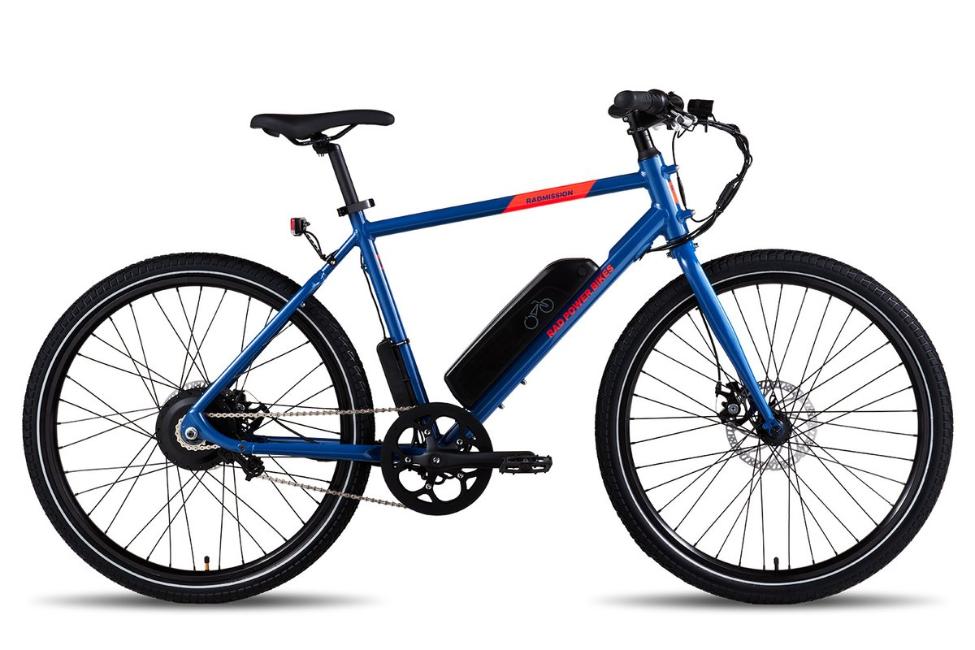
Photo Courtesy: Rad Power
| Model Name | Weight | Range |
| DOST Drop | 64.6 lbs (29 kg) | 120 miles (193 Km) |
| RadMission 1 | 50 lbs (22 kg) | 45 miles (72 km) |
| SONSORS Smart Step | 65 lbs (29 kg) | 40 miles (64 km) |
Hybrid e-bikes were created to provide the advantages of both mountain bikes and road bikes in one complete package. They typically have upright handlebars and padded seats for a more relaxed riding position and a straight/slightly bent posture.
Best for casual riding on bike paths and around the neighborhood, if you’re commuting for short distances for errands, hybrid e-bikes are a great option. They function adequately for paved roads, although they aren’t as efficient or lightweight as road bikes.
Where hybrid e-bikes shine are on unpaved or paved bike trails, but they won’t be adequate enough for off-roading like a mountain bike is. Although the tires will provide a smooth ride on pavement, their semi-smooth, medium-width treads don’t have enough grip or shock absorption or cushion for practically anything else.
If a hybrid bike has suspension, you’ll only find it in the front to smooth out small bumps. However, rigid suspension (or lack there-of) is more common. They used to be called cross bikes, but this was changed to avoid confusion with cyclocross bikes.
Hybrid e-bikes are a ‘jack-of-all-trades and a master of none.’ Someone who is looking for the benefits of most e-bikes may find a hybrid model appealing. Mostly focus on the range and battery charge time because you’ll likely use a hybrid for commuting.
Since commuting will be your ultimate goal, safety should be another focus. Check the price and the warranty to ensure dings and scratches are covered, because you’ll likely see some wear and tear during road-biking. Spend only for a model that will fulfill your needs, and only upgrade to something like a mountain or cruiser if you need an e-bike for a specialty purpose.
City E-Bikes

Photo Courtesy: Magnum
| Model Name | Weight | Range |
| Magnum Ui6 | 60 lbs (27 kg) | 60 miles (100km) |
| CUBE Elly Cruise Hybrid 400 | 55 lbs (25 kg) | 55 miles (88 km) |
| OHM Quest | 53 lbs (24 kg) | 75 miles (120 km) |
Although bicycle enthusiasts agree that a ‘city’ category exists, there aren’t bikes specifically made in this category. Instead, it acts as a descriptive term. City bikes are often called ‘urban’ or ‘commuter’ bikes as they are also used for commuting or riding in the city.
City bikes usually have the characteristics of both the cruiser and hybrid bike so, they typically have the upright riding position of a cruiser, but the wheel size of a hybrid. A city bike may also have fenders, chain guards, and a skirt or rearguard to make it easier to ride in regular clothing.
For easier maintenance and use, city e-bikes often have internally-geared read hubs and a built-in generator and lights for safer night riding. City e-bikes are sometimes called ‘Dutch bikes” because they resemble bikes used in European cities.
Urban riding doesn’t get any better than city e-bikes, because they’re functional, stylish, and are often a crowd favorite as they cater to casual riders. Any city with a well-designed bike lane will welcome the city e-bikes as they’re fast and small enough to zip through traffic.
The most crucial aspect of city e-bikes is comfort, which is a given for all e-bikes in this category. You also need adequate range, secure handling, and safety above all else since you’ll be riding on mostly paved roads.
If you decide the city e-bike is right for you, keep in mind that there’s a lot of competition in this sphere so you may feel overwhelmed by choice. Above all else, keep an eye on the price compared with its features because you can find many cost-effective and fantastic models.
Road E-Bikes
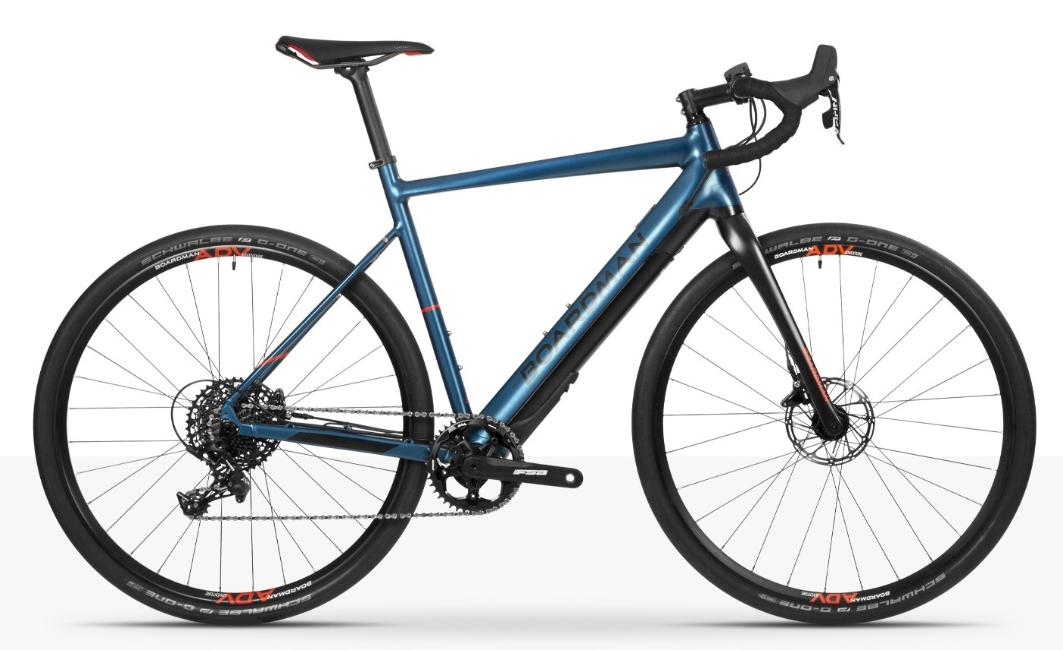
Photo Courtesy: Boardman
| Model Name | Weight | Range |
| Gtech eBike Sport | 35 lbs (16 kgs) | 30 miles (48 km) |
| Boardman ADV 8.9E | 10 lbs (4.6 kgs) | 55 miles (90 km) |
| Coboc One Soho | 30 lbs (13.7 kgs) | 50 miles (80 km) |
As the name suggests, road e-bikes are designed for smooth, paved roads. Their tires are skinny, high, and meant for fast riding. The drop handlebars can make riding a bit uncomfortable, so you need to master a bend or slouched position.
The purpose of the dropped handlebars is to make the rider more aerodynamic, so you achieve faster speeds without the wind slamming against your body and creating a wall that could slide you back. Instead, the wind will pass over your back.
Since road e-bikes are great for paved trails, they fail to produce a comfortable riding experience for unpaved or unstable trails. Don’t use these models for anything but racing or fast commuting, because the shocks and tires will not protect you against bumpy terrain.
Most road bikes aren’t suitable for carrying heavy loads, so they are not ideal for touring or commuting – just short rides with a backpack or long races. Since most e-bikes use GPS technology to calculate riding range, tech lovers will fit right in with the road e-bike crowd.
Road e-bikes a specifically for specialty riders that want to experience one type of bike riding. Since marathons are likely your thing, find an e-bike with a high capacity battery and motor because they both affect your riding experience more than any other criteria.
Some features, like staying comfortable long-term, will be more relevant if you plan to ride for an hour or longer per day. Weight and safety should also be a contributing factor, as well as the price and how that ties to your requirements.
Cyclocross/Gravel E-Bikes
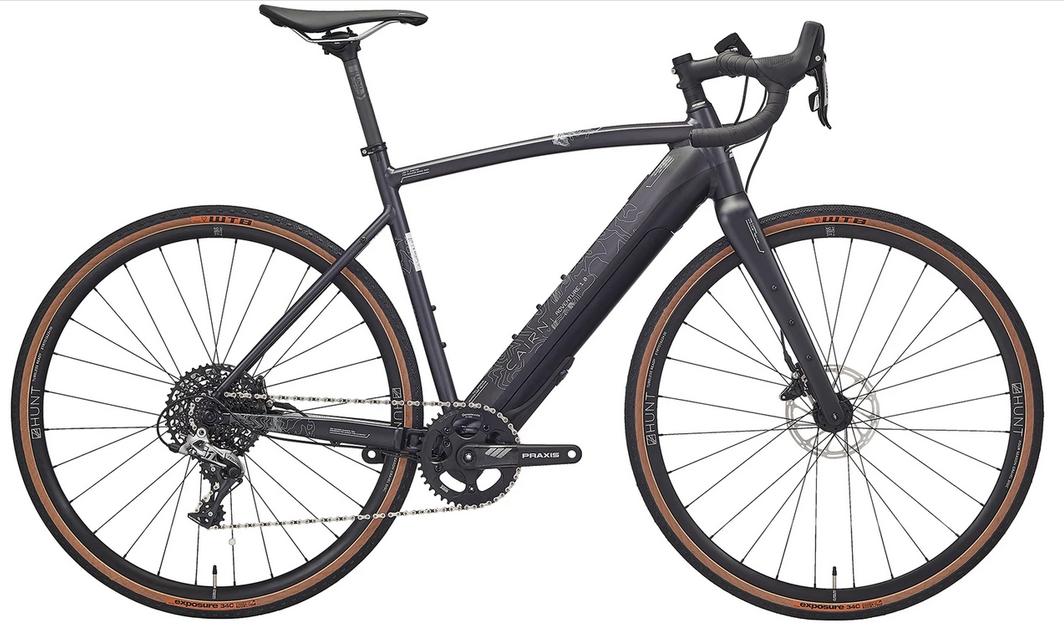
Photo Courtesy: Cairn Cycles
| Model Name | Weight | Range |
| BULLS GRINDER EVO | 53 lbs (24 kg) | 85 miles (135 km) |
| Cairn E-Adventure 1.0 | 32 lbs (14 kg) | 56 miles (90 km) |
| Yamaha Wabash | 42 lbs (19 kg) | 75 miles (120 km) |
Gravel or cyclocross e-bikes are a specialty type that is designed for racing on a mixed-surface course. Unlike road bikes, which can only ride on paved roads, the cyclocross model can ride on combination pavements, gravel, unpaved trails, and grass.
Cyclocross e-bikes have dropped handlebars like typical road bikes for less wind-resistance while riding, but the wheels are wider for better off-road traction. Gravel e-bikes also have a different style of brakes (usually disc brakes) to help prevent mud buildup on the frame.
You’ve probably heard of the term ‘cross bikes’ or ‘cx bikes’ in reference to road bikes because both the road bike and cyclocross models are confused for each other. Always check the tire width to be sure you’re picking the right model for your needs.
Keep in mind that gravel e-bikes came late in the e-bike game, which means you won’t have as many options in regards to price. For this reason, you may pick a mountain e-bike instead, but a cyclocross e-bike is actually cheaper than most high-end mountain bikes.
As for specs, you should concentrate more on your purpose for buying a gravel e-bike type. For racers, you should focus on the motor with enough power to scale steep inclines and travel through rough terrain. For casual riders, you won’t need to worry about the motor. Instead, focus on the battery and its charge time for longer commutes.
You’ll likely find a gravel e-bike for a reasonable price, but if you find that the price is similar to a mountain e-bike, just opt for one instead. Otherwise, try to find a balance of features (terrain, riding habits, and battery) for a better riding experience.
Cargo E-Bikes

Photo Courtesy: RadPower Bikes
| Model Name | Weight + Load Capacity | Range |
| RadWagon 4 | 60 lbs (27 kg) + 350 lbs (158 kg) | 45 miles (72 km) |
| Urban Arrow Shorty | 55 lbs (25 kg) + 400 lbs (181 kg) | 60 miles (96 km) |
| Tern Bicycles GSD S00 | 71 lbs (32 kg) + 440 lbs (200 kg) | 124 (200 km) |
For anyone who needs to travel long distances and carry a heavy load or a passenger, a cargo e-bike is perfect for you. We often don’t realize how much fuel it takes to carry more than one person, but you can cut an e-bikes range by more than half if you move too much weight.
Cargo e-bikes are also useful for the added stability of an often included extra tire. For this reason, they’re an excellent alternative to a motor-run tricycle or cars because of the added load capacity and the coolness factor. It’s often implied that tricycles are intended for kids.
This e-bike model often has a raised seat, flat handlebars, a large cargo basket in the front or back, and a large wheel in the front and a small tiny wheel in the back. Cargo e-bikes are more for functionally and utility, so if you want something that can go fast, get a smaller container in the front.
Should you opt for this model of e-bike to help you haul a wide variety of heavy things or averaged weighted people, but be careful when you’re shopping for one. Always prioritize the battery and motor, because if both of these don’t work in tandem, you’re not going to go far on a single charge.
Unfortunately, cargo e-bikes are some of the most expensive models available, especially if you want to carry loads of 400lbs or more. Be sure to factor in the bike’s weight before purchasing it; otherwise, you may miscalculate the load capacity and won’t be able to hold as much as you expect.
Adding more weight to a cargo e-bike than the manufacturer recommends could prematurely damage the motor and battery, or cause the e-bike to slow down. At that point, your e-bike won’t perform as well, which defeats the purpose of carrying more cargo.
Commuter E-Bikes
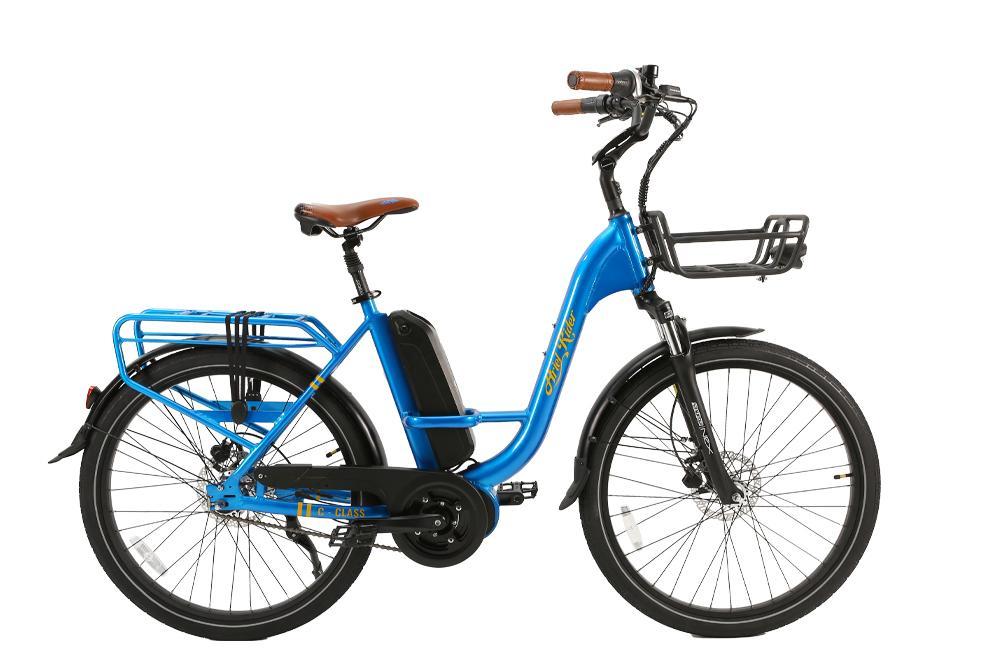
Photo Courtesy: Ariel Rider
| Model Name | Weight | Range |
| Ariel Rider C-Class | 62 lbs (28 kg) | 65 miles (104 km) |
| Trek Verve + 2 | 51 lbs (23 kg) | 82 miles (130 km) |
| RadCity 4 | 56 lbs (25 kg) | 44 miles (72 km) |
Most e-bikes are capable of getting the job done for short commutes, but a ‘commuter e-bike’ is in its own class because commuting is one of the most common e-bike uses. If you want a no-nonsense e-bike that gets you from point A to point B as comfortably as possible, choose a commuter bicycle.
A folding, city, and cruiser type could supplement for a commuter, but commuters tend to be more cost-effective because they don’t come with techy features that could jack up the price. Some city bikes often overlap with commuting types.
Since commuters often look and act like city models, you’ll find that the upright riding position is shared as it’s the most comfortable. Commuters also have larger, more shock absorbent wheels to protect against cobblestone or cracked sidewalks.
Comfort will be the most crucial feature of these models. Commuters are for daily bike rides, so ease of use is necessary. You shouldn’t ignore riding range or motor assist either because they need to fit your terrain and riding requirements.
Don’t overlook safety features, because you’ll be bobbing and weaving through traffic or pedestrians daily. Since commuters aren’t big on bonus features, you may need to pay a premium for GPS or display. If you want these features, keep in mind that many e-bike displays are purchasable after buying your e-bike.
Foldable E-Bikes

Photo Courtesy: Rad Power
| Model Name | Weight | Range |
| RadMini 4 | 67 lbs (30 kg) | 45 miles (72 km) |
| Gocycle GS | 49 lbs (22 kg) | 45 miles (72 km) |
| Swagtron EB7 | 48 lbs (21 kg) | 15.5 miles (24 km) |
Foldable e-bikes are bicycles that fold, usually in half, and are ideal for anyone who needs to travel with their e-bike. Some commutes take longer than 25 minutes and may require the rider to hop on a subway, bus, or train. Bringing along a foldable e-bike can help with that.
As an alternative, foldable e-bikes are perfect for anyone who wants to bike in a foreign country and wants to pack it on a flight, or if the rider lives in a small apartment will little storage space. You can also store these models under your desk once you get to work for safekeeping.
Most foldable e-bikes have smaller wheels, making them less efficient and harder to handle than a typical commuter. Think of a folding e-bike like a BMX, as they tend to be low to the ground, more compact, and require the rider to slouch.
One immediate concern for anyone who wants to use a foldable e-bike is its weight. Most e-bikes are more substantial because of the motor and battery, but if you aren’t capable of lugging around 50 lbs, find an e-bike that weighs 30 lbs or less for your comfort.
Riding range and motor power will be necessary, but it’s unlikely you’ll find a model capable of a lot of power or range that exceeds 44 miles (72 km) unless you want to pay a hefty price for it. Also, look at the motor size on the bike once folded, because it may jut out too much.
Expect to pay more than your average commuter. The technology required to make an e-bike foldable, light, and capable enough to carry a decent load capacity is always expensive. Folding e-bikes tend to be more economical than other types of electric bikes.
Are you an e-bike enthusiast?
Are you interested in many other articles, like this one, that gives in-depth information about different e-bike models?
Browse our site for more information on the best electric bikes and scooters that can make your commute more stylish and fun.
Before you go, leave a comment on your favorite class or model of e-bike or read one of our other articles about the history of bicycles and e-bikes.
The post Which Electric Bike to Buy? Deciding on the Right e-Bike For You appeared first on eRide Guides.
]]>The post Electric Bikes for Beginners: Everything you Need to Know Before you Buy! appeared first on eRide Guides.
]]>Due to these advancements, it’s not uncommon to see e-bikes existing with traditional, human-powered bicycles.
Dissecting an electric bicycle doesn’t have to be complicated. In fact, they’re very similar to the first bicycle you used when you were a child. With an added motor, battery, throttle, and drivetrain, you can exceed speeds of 28 mph (45 km/h) without breaking a sweat.
This article will act as an introduction to anyone interested in an electric bike. But first, we need to determine what an e-bike is before discussing its components, laws, maintenance, and more.
What is an Electric Bike?
Let’s look at what an electric bike is by comparing it to a traditional human-powered bicycle. To put it simply, an electric bike is a regular bike with an electrical drive system. This consists of a battery, motor, a way to integrate the motor’s power in the drive train, and a way to control it.
The Propella 7-Speed E-Bike has all the components of a traditional e-bike:

Photo Courtesy: Propella
- Purple Circle: The battery that powers the motor sits underneath the passenger bar.
- Red Circle: The throttle, which controls the power, is similar to a motorcycle handle.
- Orange Circle: Mid-drive motor helps to propel the e-bike forward.
- Green Circle: The drivetrain integrates the power located in the rear wheel.
Without these four critical components, the e-bike becomes a human-powered bicycle. Once you remove these components, an e-bike can become a bicycle as long as there are pedals to move the chain and gears to rotate the wheels.
What is the Difference Between an E-Bike and a Motorcycle?
Although a motorcycle and e-bike look similar from a glance, they are entirely different from each other. The most significant difference is what powers a motorcycle. Electric motorcycles exist, but a gas-powered motorbike has unlimited range, is faster, and has room for an extra passenger.
As a disadvantage, motorcycles are very loud, expensive, and take up a lot of space. They’re also more costly to maintain.
An e-bike costs less, even when compared to the initial price of the purchase, battery replacements, and maintenance. They’re quiet, are parkable virtually anywhere, and benefit your physical fitness.
The only thing you miss out on is the motorcycles’ cool’ factor. But, like how cigarettes have come and gone out of style, so will gas-powered motorbikes.
If you prefer a compact, lightweight mode of transportation that doesn’t require insurance or registration, get an e-bike. However, if you want something more road-worthy with a better suspension and visibility, purchase a motorcycle instead.
What is the Difference Between an E-Bike and a Moped?
An electric scooter (or moped) is a purpose-built machine with electric propulsion. Mopeds look similar to gas scooters with a platform for the user’s feet and a step-through-style base. Some of these scooters are classified as “power-assisted bicycles.”
Despite this classification, mopeds are very different from e-bikes. First, mopeds do not have pedals, so you can’t use them as an exercise apparatus. Mopeds also require a driver’s license in the U.S., insurance, and registration, whereas e-bikes do not.
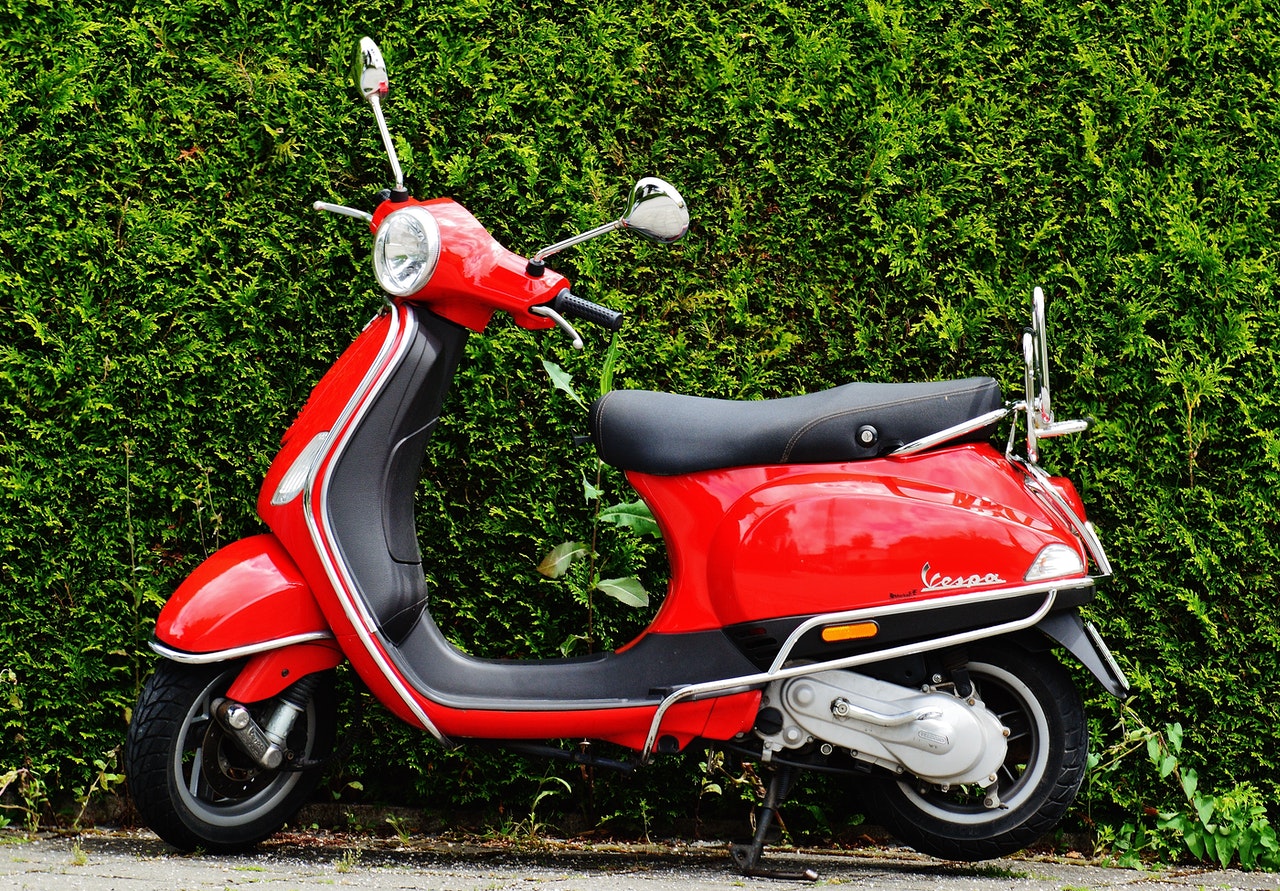
Photo Courtesy: PixaBay/Pexel
Mopeds have a limit to where they can operate. Although they can travel on the street or within bike lanes, they aren’t allowed on sidewalks and can’t park in bicycle areas. An electric bike is still considered a bicycle and can go wherever a human-powered bike can go.
Finally, a moped cannot travel anywhere but within a city. An e-bike can go up a mountain with just the motor alone. If you do want a moped, they can reach higher speeds than a typical e-bike at 30 mph (48 km/h) where an e-bike can only legally cap out at 28 mph (45 km/h).
How do E-Bikes Work?
Mid-Drive
An electric-mid-drive motor is the main component that makes riding an e-bike effortless. This motor type has more torque and higher performance than a traditional hub motor. Since it drives the crank and not the wheel, it takes advantage of the guards to amplify the bike’s power.
Mid-drives are often close to the ground to improve the handling of the e-bike. The lower the mid-drive, the better your center of gravity, as it distributes the weight better throughout the bike.
Battery
You need the battery to operate an e-bike; otherwise, it becomes a regular bike! A typical battery can provide 40 miles (64 km) of riding, but the smaller, more compact designs may only take you 20 miles. You can remove them easily to clean or charge.
Drivetrain
A drivetrain delivers power to the driving wheels and converts torque and speed via the gears. Some drivetrains let you turn the resistance up or down so you can comfortably ride up steep mountains. The dial is typically located around the gears next to the drivetrain.
Throttle
You’ve likely seen a throttle on a motorcycle, and they serve the exact same purpose – it kicks on the motor and lets you control the e-bikes speed. When you turn the throttle forward, the e-bike will drive. The speed of which the e-bike goes is determined by how far forward you twist the throttle.
Not all e-bikes are made the same, but they all have these four components. Most electric bicycles also come with disc brakes, suspension, and pedals.
How do you Ride an E-bike?

Photo Courtesy: Snapwire/Pexel
Some e-bikes have pedals that let you ride like a human-powered bicycle but with the added assistance of a motor to propel you forward.
However, some e-bikes don’t come with pedals. Foldable or small electric bikes tend not to have a pedaling option. Instead, a user would have to place their feet on the spokes where the pedals would be and use the throttles to move forward.
Most e-bikes have either option so the rider can ride without any human component. This is great for office workers who want to arrive at the job without sweating. At the same time, that same office worker could get in some great cardio during their time-off by using the pedals only and no throttle for assistance.
Common Features of an E-Bike
Besides the motor, throttle, drivetrain, and battery, many other features come with your typical e-bike.
Folding
An excellent folding electric bike can store securely within your home, in a car, or on public transport. If your commute requires a quick detour on the subway, or you live in a small apartment or a home without a garage – pick a folding bike.
Folding e-bikes tend to be lighter than traditional, non-folding types. Keep in mind that a great bicycle with a decent motor and battery will still weigh 40 or 50 pounds. Lugging it around will make you stronger!
Braking System
An electric braking system is universal for e-bikes, but when given a choice, always choose disc brakes over conventional types. Disc brakes offer greater stopping power, which is helpful for long descents or during wet weather. They’re also more precise because wheel lockup is less likely.
Electronic Panel
An electronic panel display isn’t necessary, but it can enhance your riding experience. Find one that displays power status, distance, headlights, PAS grades, speed, and error messages. An estimated battery level display can ensure you don’t run out of charge far away from home.
Range
The range of the battery depends on the type of riding you’re doing, so it’s challenging to list a range spec on an e-bike as a sale point. The manufacturer assumes you’ll use an e-bike on a flat sidewalk because you’ll have the most extended range on terrain with minimum effort.
To calculate the watt hours (range) of a battery pack, multiply the voltage by amp hours. A 36-volt 10-Ah battery pack has 360-watt hours (36 X 10 = 360). Each mile costs 20-watt hours on average. Therefore, a 360-watt hour pack will get you 18 miles on one charge.
Tires/Suspension
Suspension isn’t always a given on e-bikes, similar to how cost-effective bicycles don’t have adequate shocks. Instead, e-bike manufacturers will install thicker, more inflated tires to improve stability on bumpy roads or sidewalks.
Common Accessories for an E-Bike
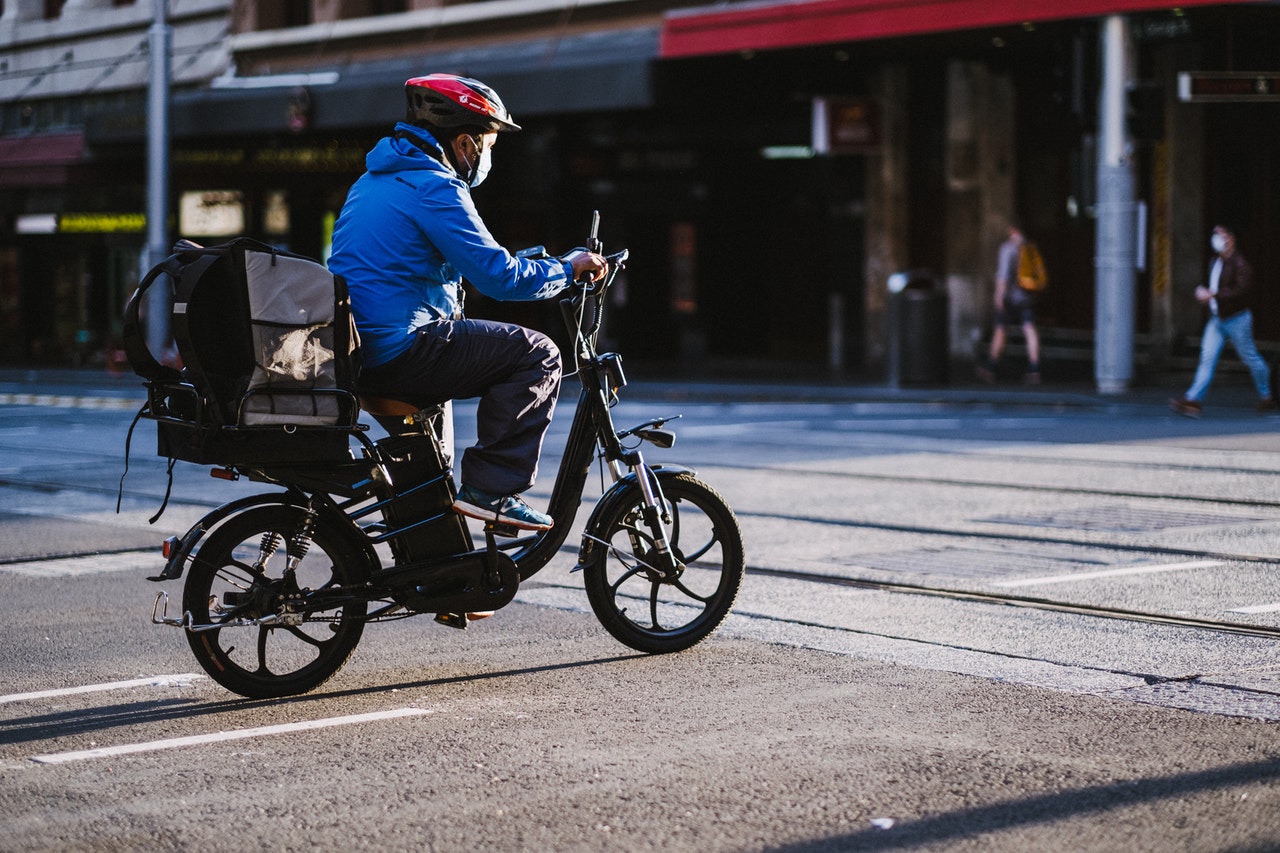
Photo Courtesy: Kate Trifo/Pexel
Are you thinking of adding a few accessories to your e-bike, so it stands out from the crowd?
Consider these items to improve your safety and the look and feel of your bike.
- Helmet: Safety is essential. Since e-bikes exceed 20 mph (32.19 km/h), a crash could be fatal. Use a DOT helmet made for motorcycle users to protect your noggin from falls.
- Side Mirrors: Most e-bikes don’t come with mirrors, but they’re vital to your safety. Equip them to the end of your handlebars on each side for maximum visibility.
- Lights: If you ride at night, you need headlights for safety. Pick up taillights too so vehicles can see you in the dark on country roads or alleyways.
- Basket: You could use a backpack, but if you don’t want to get your back sweaty put a front basket that’s deep enough to store three bags of groceries.
- Suspension Seatpost: Great suspension is only found on expensive e-bikes. For anything other than high end, get a suspension seat for a smoother ride.
We also recommend grips for your handlebars, fenders to protect your chains, and pop-off pedals so your e-bike can fit easier in cars or public transit. Always buy bike tools for standard maintenance and repair jobs.
Growing Popularity of E-Bikes
Every year the popularity of e-bikes is increasing by more than 60% on average worldwide. In 2019, e-bike sales rose 73% at specialty shops. The more popular models are pedal-assisted, move at 20 mph (32.19 km/h), and fold.
E-bikes are the fastest-growing segment in the cycling market, with over $100 million in sales in the United States as of 2019.
“E-bikes are making recreation and transportation easier in cities and urban locations across the United States,” said Taldi Harrison, the government and community affairs manager for REI. “E-bikes are a dependable option for people of all backgrounds and help make getting outside-accessible for all.”
About half of all e-bikes sold are bought by people who never considered themselves cyclists, or who haven’t ridden a bike in years. E-bikes broaden the audience for who can use motorized transportation without the setback of a clunky or expensive car.
However, there is a downside to this rapid popularity spike. There are virtually no laws in place to regulate the use of motorized bicycles.
Laws and Regulations
The US Laws and the Lack of Regulation
At the federal level, the U.S. Consumer Product Safety Commission regulates e-bikes for product safety for manufacturing at the first sale. Without clear guidelines, many states adopted outdated rules governing e-bikes that treat them as an extension to human-powered bikes or motorcycles.
Some have no regulation what-so-ever, so individual states tend to suggest a 20 mph (32 km/h) max speed. This loose approach has led to multiple injuries that were easily avoidable. From 2000 to 2017, 245 million injuries occurred from electric scooters or bicycles.
The Rapid Need for Legalization of the 3-Class System
Since 2014, the national bicycle advocacy group PeopleForBikes helped over 30 states pass standardized regulation for e-bikes using the 3-Class System. This model legislation defines three standard classes of e-bikes based on wattage, speed, and operation.
Class 1 and Class 2 are usually allowed where pedal bikes are allowed, but Class 3 bikes are typically reserved for road use only. In Europe, a cyclist must place a highly visible sticker on the frame to indicate an e-bike’s Class.
In 2015, California was the first state to adopt the 3-Class System, but since then, 26 states now define e-bikes in a Three Class structure. The graphic below outlines where states have proper legislation, which are acceptable and problematic and need work.

Photo Courtesy: Katrina Dent
Legislated states use the 3-Class System. Acceptable states have no age limit, no licensing registration, and e-bikes are treated as bicycles. Finally, problematic states treat e-bikes as motor vehicles and have confusing laws and practices that aren’t found in state law.
Different Types and Categories
Most countries follow the 3-Class system to dictate the difference between the different types and categories of e-bikes. These classes are further broken down into terrain subclasses determined by the motor and battery application and use.
The 3-Class/Type System
Here is a breakdown on which e-bikes classify Class 1, Class 2, and Class 3 under the legislation.
- Class 1: Assists pedaling but not your throttle, these e-bikes are passive and are allowed to function on bike paths. Pedal-assist only (absolutely no throttle), and have a maximum assisted speed of 20 mph (32.19 km/h).
- Class 2: Known as low-speed throttle-assisted e-bikes. These e-bikes have motors that proper the cyclist without pedaling. The rider cannot exceed more than 20 mph (32.19 km/h) like Class 1, except Class 2 e-bikes must be throttle-assisted.
- Class 3: Known as speed pedal-assisted electric bikes and assist the rider if they’re pedaling. Cannot have a throttle. Class 3 e-bikes can have a maximum assisted speed of 28 mph (45 km/h). However, the U.S. only allows bikes on the road that have a maximum of 20 mph (32.19 km/h).
All e-bikes, no matter the Class, limit the motor’s power to 1 horsepower (750W).
Terrain Classes
E-bikes are separated between two types of terrain: rough trails and leisure. Most e-bikes are geared towards leisure activity because consumers use these to go to and from work. Mountain bikes are useful for rural communities where cars are expensive or inaccessible.
Rough Trails:
Similar to a traditional bike, e-bikes are capable of cycling up steep hills for an extended period with the proper battery and motor (750w minimum preferred). These bikes are available at hardtails or full suspension. The full suspension is better for rougher ground.
Leisure and City:
All e-bikes can function spectacularly on flat land or in a cityscape because they were initially designed for this purpose. To get the most out of the battery and motor, calculate your weight against the wattage of the battery. For example, a 110-pound woman can use a 250w battery to its fullest extent, while a 150-pound woman should use a 500w or more for better results.
Some companies have a hybrid category of leisure and rough, but it’s better to buy a bike specifically for its purpose because it will perform better. If you find that you share your time between mountain biking and leisure, then purchase a hybrid. Otherwise, pick one or the other.
Speed and Pedaling
The speed of an e-bike depends on the Class number, battery, and motor. Most e-bikes range from 20 mph (32.19 km/h) to 28 mph (45 km/h). Anything faster than that is illegal in multiple U.S. states. Use the below chart to determine max speed vs. batter and motor.
| Battery + Motor (Flat Terrain 165 lbs Male) | Max Speed | Average E-Bike Cost | Average Charge Time |
| 250w | 20 mph (32.19 km/h) | $500 – $1000 | 20 minutes |
| 500w | 25 mph (40.23 km/h) | $750 – $1250 | 40 minutes |
| 750w | 28 mph (45 km/h) | $750 – $1500 | 60 minutes |
| 1000w | 35 mph (56.32 km/h) | $1000 – $1500 | 80 minutes |
| 1500w | 40 mph (64 km/h) | $1500 – $2000+ | 120 minutes |
* Green is within legal limits, red is considered illegal by many U.S. states
If the e-bike has a pedal assist, it’s possible to exceed your bike’s maximum speed as long as you remain pedaling. However, pedaling excessively could damage the motor if you’re consistently going above the max speed and using the throttle in tandem.
Safety Tips
Although e-bikes are a great way to get around, they still require attention to ensure your fun ride doesn’t become dangerous. Many electric bicycle safety tips apply to standard cycling, while others are specific to motorized vehicles.
- Wear A Helmet
- Use Headlights and Taillights
- Use a Horn or Bell to Warn Other Pedestrians
- >Don’t Ride Against Traffic
- Use Bike Lanes Where Possible
- Keep Tires Properly Inflated
- Practice Defensive Driving
- Use Your Mirrors
Above all, never ride drunk. Although bikes do not require a license to operate, you can still get seriously injured if you’re not 100% aware of your actions. It isn’t worth it. Fold your bike into a cab, if possible, or walk your bike home on the sidewalk.
Insurance
Insurance for e-bikes does exist, but it isn’t necessary to purchase in the United States. The policy cost depends on your coverage, but we recommend liability coverage to cover third party damages like property or medical expenses.
However, there are many things insurance won’t cover, like a stolen battery, manufacturer malfunctions, or theft of the entire bike.
Homeowners and renters insurance will not cover electric bicycles. Auto Insurance also won’t cover an e-bike (only other motorized vehicles like mopeds or motorcycles) because you don’t require a license to operate it. You will need to seek out third-party insurance coverage.
Average Lifespan
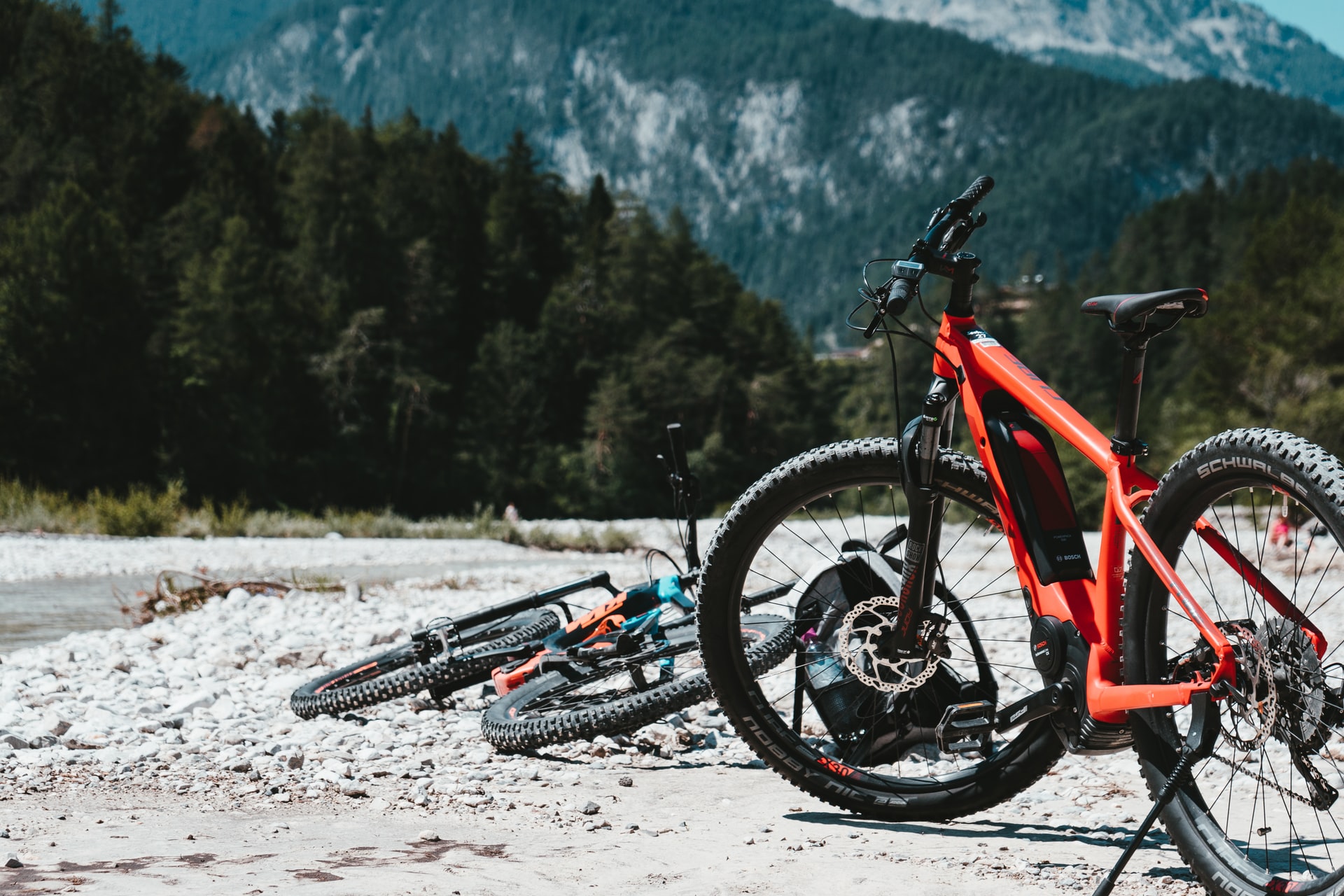
Photo Courtesy: Julian Hochgesang/Unsplash
A quality e-bike made of lithium-ion or lithium-polymer technology is usually capable of 1K full-charge-discharge cycles. However, most users don’t use their e-bike until it’s dead. Therefore, an average user will get three to five years out of one electric bike battery.
The average lifespan of your e-bike could diminish if you take poor care of the motor, battery, and drivetrain. Use these tips to extend the life of the electronic components on your e-bike.
Maintenance
Schedule A Weekly Cleaning: Regular cleaning to keep off the dirt, dust, and debris from getting into the engine should be your priority as an e-bike owner. It helps keep the mechanical parts functioning. However, never use a pressurized hose or stream of water because it could expose jetting liquid into the electrical system – causing it to malfunction.
Lubrication: Similar to a steel bicycle chain, the e-bike chains and gears need proper lubrication, or else it will rush, seize, or break. You should use a special cleaning solution specific for cleaning bike chains. For example, if you use WD-40, the oil will fly up onto your pants as you ride. Do this once a week if you bike often.
Tire Pressure: The tires’ sidewalls should inform you of the ideal pressure for that tire type. Check the pressure by using a pressure gauge – don’t just eyeball it because you risk too little traction or bloated tires. Inflate them properly for a smoother ride.
Check the Bolts: While you’re cleaning, check for any loose nuts, bolts, or screws. Use your fingers to check the tightness. If you can screw the bolts off with your fingers, they’re way too loose. Don’t tighten the bolts too much, or you won’t be able to get them off!
Battery: The most critical electrical piece on your e-bike is the battery, so treat it as such. Read the manufacturer’s instructions before changing it, or you could damage the battery or the bike. Know that battery replacement can be expensive, so take care of it by protecting it against rain, dirt, and debris.
Brakes: Check these every few weeks by pumping them at slow speeds. It’s essential to have effective brakes on any motorized vehicle. Otherwise, you could be in a severe accident. Brake pads are easy and cheap to replace if necessary.
Storage Tips: Always keep your e-bike in a cool, dry place away from any potential rain or harsh weather conditions. It’s better to keep it indoors, either in a garage or in your home. Keep the bike off the ground during the winter, so it’s less likely to get knocked or ruined.
Is an E-Bike a Good Investment?
Electric bikes make riding convenient and effortless. You may wonder if the point of getting a bike is for the exercise, but the real reason to use an e-bike is to get from point A to point B comfortably and inexpensively.
Although e-bikes will never wholly replace a regular bike or a car, it can eliminate the barriers that stop people riding, such as hills, distance, or health. You won’t have to worry if you’re strong enough, have enough endurance, or enough confidence to get back on the road.
If riding represents stress-reduction, freedom, better health, enjoyment, and free time, an e-bike will be a good investment for you, especially if you want to add a bit more exercise to your life and reduced car traffic.
Are you an e-bike enthusiast?
Are you interested in more in-depth articles on e-bikes? Stay on our website for more content.
Before you go, leave a comment about your thoughts on owning an e-bike, or read one of our other articles about the average electric bicycles top-speed.
The post Electric Bikes for Beginners: Everything you Need to Know Before you Buy! appeared first on eRide Guides.
]]>The post The History of Electric Bikes and the Bicycle appeared first on eRide Guides.
]]>A German baron named Karl Von Drais made the first significant development in 1817 – but the bicycle was mostly a clunky wooden prototype that could only be powered by legs kicking the ground.
To truly understand the relationship between the traditional bicycle and the electric bike, it’s essential to study the history of all pedelecs. Although e-bikes were a concept in the 1890s, it wasn’t until the 1990’s that batteries were light enough to power them.
Let’s look at the earliest unverified bicycle, the invention of what we know as a ‘bicycle’ and it’s many improvements.
Finally, we’ll look at the electric bike and its switch from a bulky clunky transportation device to the incredible piece of technology it is today.
The Unverified History of the Bicycle
Before 1817, many inventors sketched up the concept of a bicycle. To qualify a piece of technology as a ‘bicycle,’ it has to be a human transport device with two wheels that requires balancing by the rider.
A sketch done around 1500 AD attributed to Gian Giacomo Caprotti, a pupil of Leonardo da Cinci, was discovered in the modern era.
After some research by bicycle historian Hans-Erhard Lessing, it was determined to be a purposeful fraud.
However, philologist and lexicographer Prof. Augusto Marinoni said otherwise. When he was tasked to look through the transcription of Leonardo’s Codex Atlanticus (a twelve-volume collection of DiVinci’s drawings), he determined it was likely an accurate drawing (see drawing here).
Another unverified drawing comes from a mostly undocumented artist Comte de Sivrac who developed something called the célérifère (see here) in 1792.
It resembled a Hobby Horse, had a seat, two wheels, and handlebars that could turn the front wheel. The rider would push the célérifère by pushing it along with their legs and feet.
Current historians state that there is no proof that the two-wheel célérifère existed, although there were four-wheeler versions.
The design was misinterpreted by Louis Baudry de Saunier, a well-known French journalist in 1891 while doing a collum for bicycle history.
The Birth of the Bicycle: 1817 to 1819
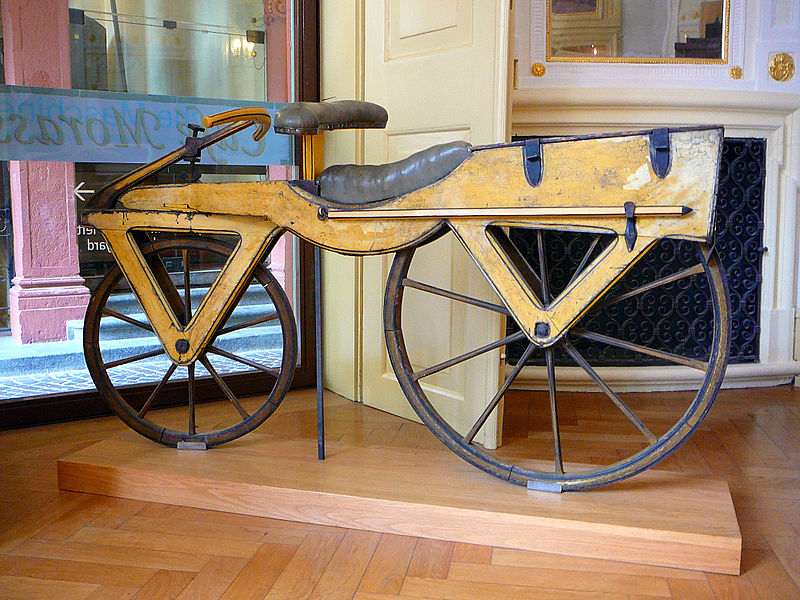
Photo Courtesy: Gun Powder Ma/Wikipedia
Baron Karl von Drais
The first bicycle belonged to Baron Karl von Drais, who acted as a civil servant to the Grand Duke of Baden. Called the Laufmaschine, Draisine, or draisienne, this wooden bicycle was created in 1817 and patented the next year.
It was the first commercially successful two-wheel, steerable, human-powered machine that was later re-branded as the velocipede and often called the dandy horse or hobby-horse. It was documented that Drais wanted a new type of vehicle to reduce the reliance on horses.
On Drais’s first ride from Mannheim, he covered 8 miles (13 km) in less than an hour.
Constructed mostly of wood, the Laufmaschine weighed 48 lbs and had wheel bearings, iron-shod wheels, brass bushings, and rear-wheel brakes.
Its popularity took off, but authorities soon limited its use because of the multiple accidents it caused. Still, many other inventors tried their hand at making new patented pedantic machines like the pedestrian curricle or the velocipede.
Denis Johnson
However, the name didn’t stick. It wasn’t until the modern era that the word “bicycle” became a familiar name.
Hobby horse was popular as it resembled the children’s toy, and the dandy horse was used as a cheeky way to make fun of the foppish English men that frequently rode them.
Denis Johnson’s invention in 1818 was more elegant because of its serpentine shape instead of the straight Drais model.
In 1819, the hobby-horse became the next big craze in London but was cut short when dandies noticed their boots getting worn down during riding.
Regardless, Drais’s velocipede provided the basis for all other bicycles to follow. Later, a French metalworker in 1863 created the rotary cranks and pedals to the front wheel hub, which ushered in the birth of the bicycle as we know today.
Scottish Two-Wheel Inventions: 1830s
One of the first mechanically propelled two-wheel vehicles belonged to inventor Kirkpatrick Macmillan, a Scottish blacksmith who made his invention in 1839. His nephew confirmed that his uncle developed a rear-wheel-drive design using mid-mounted riddles that connected with rods to a rear crank.
The Tretkurbelfahrrad by Philipp Moritz Fisher: 1850s
Another German was in the center of a new invention. Philipp Moritz Fischer used the draisine at a young age to travel to and from school.
He created the first bike with pedals (called the Tretkurbelfahrrad) in 1853, which didn’t require the user to propel themselves with their legs.
Boneshaker or Velocipede: 1860s

Photo Courtesy: Unknown author/Wikipedia
French inventors changed the design of the velocipede in 1863. It used rotary cranks and pedals mounted to the front wheel. It was difficult to steer, but it was possible to hit faster speeds due to the pedals positioning and the reduced weight of the metal frame.
These new additions made it possible to mass-produce the vehicle. Now, braking was possible due to the added metal components. In England, the velocipede earned the nickname “boneshaker” due to how it shook when riding on cobblestone rodes.
A patent made by Pierre Lallement means that the invention of pedals was given to him, although Fisher created pedals years earlier. Lallement’s patent drawing shows a machine that looks similar to Johnsons but with pedals and a rotary crank in 1866.
In the early 1860s, Pierre Michaux started producing parts for the velocipede on a large scale and created the Michaux company, which mass-produced bicycle parts. They dominated the industry for many years.
High-Wheel Bicycle: 1870s
The penny-farthing was the next big leap in bicycle innovation. It was high off the ground, contained one large wheel in the front and a small one in the back, and was capable of higher speeds and were primarily considered unsafe.
At this point, the bicycle was considered a high-class symbol. It was priced way out of the range of an average working-class worker until the 1890s, where the price decreased significantly due to the accessibility of parts.
Safety Bicycle: 1880s and 1890s
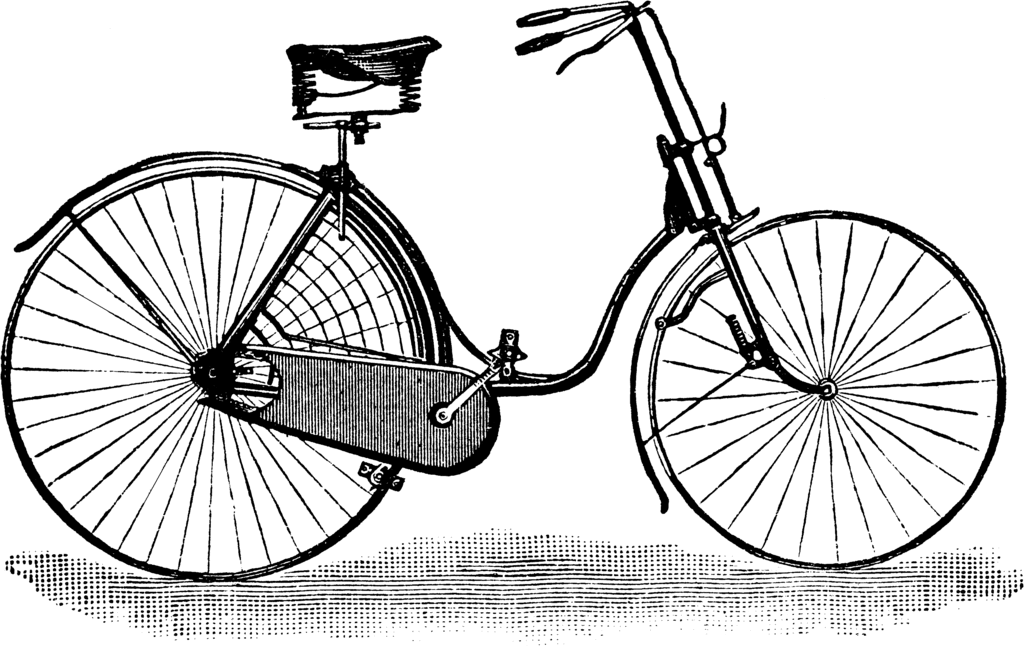
Photo Courtesy: Unknown author/Wikipedia
The safety bicycle is widely thought of as the most critical change in the history of the bike. It shifted the way others saw bicycling as a dangerous hobby to an everyday transportation tool that anyone of any age could enjoy.
Although there were still safety issues with the original safety bicycle of 1884 (as it was still too high off the ground), it added a chain-drive front wheel. Inventors later experimented with a rear-wheel chain drive.
John Kemp Starley produced the first successful safety bicycle called the ‘Rover’ in 1885 but wasn’t patented. It had a steerable front wheel with a large caster and equally sized wheels and a chain drive to the rear wheel.
The Rover was imitated countless times and wholly replaced the high-wheeler as it was easier to ride on paved streets and dirt roads. However, it wasn’t as comfortable as the high-wheelers because of the smaller wheel size and lack of suspension.
John Dunlop’s reinvention of the pneumatic bicycle tire helped create a smoother ride and made the complicated bicycle suspension obsolete. This also meant the diamond pattern became the most efficient design, which was later foldable after African American inventor Issac R Johnson lodged a patten for his design.
The chain drive improved speed and comfort, which allowed for a smooth, relaxed, and injury-free pedaling experience. Riders could easily steer around corners due to its lighter design and simple construction.
The Invention of the Electric Bicycle: 1890s
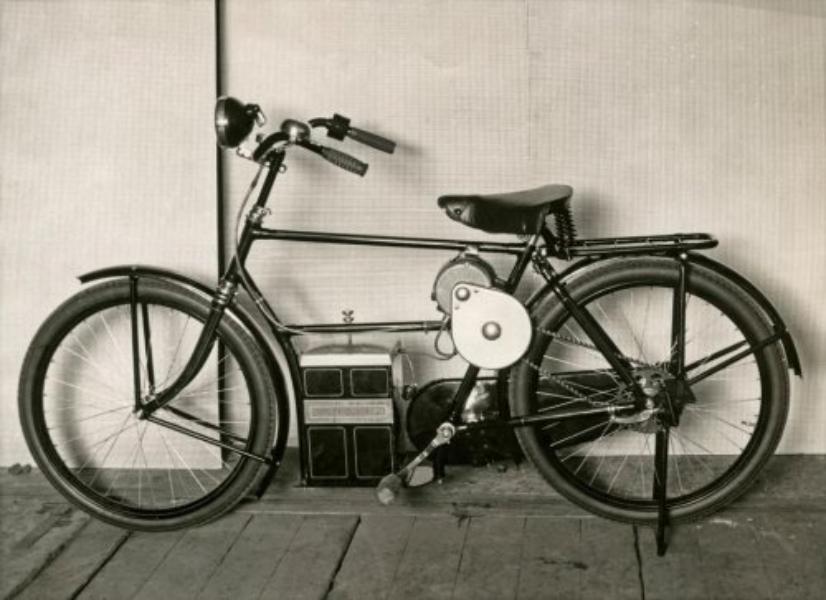
Photo Courtesy: GaHetNa (Nationaal Archief NL)/Wikipedia
Electric bikes were documented within various U.S. patents. In 1895, Ogden Bolton Jr. created a patent for the first battery-powered bicycle with a 6-pole brush-and-commutator direct current hub motor mounted at the rear wheel.
At the time, this electric bicycle had no gears, and the motor could draw up 100 amperes from a 10-volt battery. It was very clunky and barely moved. All human-powered bikes at the time could maintain faster speeds that this primitive e-bike.
In 1897, Hosea W. Libbey invented an electric bike that propelled by using a double electric motor. It was designed within the hub of the crankset axle. This was reinvented in the 1990s by Giant Lafree e-bikes.
1898 saw a rear-wheel-drive e-bike that used a driving belt, and 1899 depicted a roller wheel style electric bicycle. Until the 1960s, electric bike inventions remained stagnant because the batteries and frames were too clunky, and the battery lasted less than an hour.
The Last of the 19th Century: Roadsters
By the 1890s, the roadster was pattened and well documented. Its design included a step-through frame rather than the diamond shape that the gentleman’s model had. This made it easy for ladies to mount the bicycle with dresses and skirts.
The frame was made of steel, the spokes were positioned lower (so dresses and skirts wouldn’t get caught) and had functional coaster brakes, drum brakes, or rim brakes. This design grew rapidly and was nicknamed the Dutch cycle, as 85% of all roadsters were produced in the Netherlands. The primary demographic was the British.
However, the decline of all bicycles was starting to occur – though mostly in the United States. There was a slight decline in the 1900s for Europe, but it still remained strong throughout the 1900s – 1940s.
The Decline in US Popularity in the Bicycle Market
Even to this day, Europeans still love the bicycle and the freedom it gives to its people. On the other end of the pond, the United States fell out of love with the bicycle, and its many renditions and innovations.
Automobiles became the most preferred means of transportation due to their comfort. The average person didn’t need to use their own kinesthetic power to move a transportation device, which was attractive to many Americans – especially with the upper-class.
In the 1920s, bicycles were gradually becoming children’s toys, and by the 1940s, most bikes were made for children. Europeans kept cycling as a mostly adult activity, and hobbies like bicycle racing, commuting, and cyclo-touring became popular activities.
Even after the invention of the automobile and motorcycle, the bicycle remained the preferred mode of transportation for Europeans. Manufacturers such as Raleigh, BSA, Philips, Carton, Hercules, and Rudge-Whitworth monopolized the market.
Technical Innovations: 1900s to 1930s
Although there was stagnation compared to other years, bicycles continued to develop throughout the early 20th century. France developed many cyclo-tourist ventures for tourists, and in the 1930s, European racing organizations started to pop up.
Gearing and the ability to shift gears became vogue. Now, the rear wheel had a sprocket on either side of the hub. Unlike modern models, riders had to stop, remove the wheel, flip it around and remount it to change gears.
World War II and Military Usage: 1940s

Photo Courtesy: BreTho/Wikipedia
Although there were multiple-speed bicycles available on the market, military bicycles were single-speed. Paratroopers would drop bicycles to military men for their use, which created the term “bomber bikes.”
Many units specifically used bicycles as a means for transportation, like the German Voksgrenadier. Their Invasion of Poland saw 196 bikes and 1 motorcycle. 41 companies specifically created bicycles for infantrymen.
The Japanese used over 50,000 bicycle troops during the Malayan Campain. They were so popular and needed for Japanese military men that they confiscated them from Japanese citizens for their use. They would often carry 80 pounds of equipment while riding, whereas a British soldier could only carry a maximum of 40 pounds.
The Flying Pigeon in China: 1950s/1960s to 1980s
One interesting point in the history of the bicycle was the invention of the flying pigeon, although it looked similar to all other 1950s cruisers at the time. It became a massive phenomenon in the People’s Republic of China and was one of the only government-approved means of transport.
The Flying Pidgeon became a status symbol to Chinese citizens along with a sewing machine and the watch. If you had all three, it meant that you were a well-to-do and classy person who has a significant amount of wealth. Chinese citizens couldn’t buy them fast enough.
During the 1960s and 1970s, the Flying Pidgeon logo became the most popular mechanized vehicle on the planet. In 1986, over 3 million cycles were sold, and there was an incredibly long waiting list for a black model popular with workers. You needed to have good guanxi (loosely translated to connections and or relationships) to even purchase one.
The North American Cruiser and Racer: 1950s, 1960s, 1970s
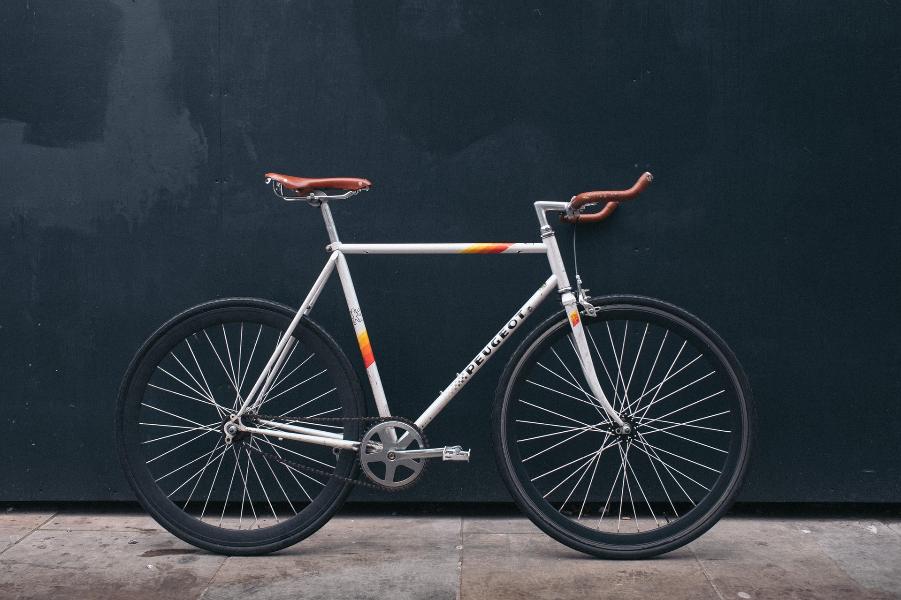
Photo Courtesy: Robert Bye/Unsplash
In Noth America, the cruiser and racer were among the most popular bicycle style. The cruiser, which was popular with hobby cyclists, had pedal-driven brakes, one gear, and balloon tires that helped with shock absorption. It was popular because of its comfort and durability.
Also in the 1950s, the racer became incredibly popular in North America. The racer, also called the sports roadster by Americans, became popular with adult cyclists that wanted an alternative to the cruiser. It was faster and better at climbing hills because of its lighter weight, narrow tires, multiple gears, and tall wheels.
There was another surge in popularity for bicycling in the 1960s thanks to interest in exercising and an attitude shift to more energy-efficient transportation sources. This led to the 1970s bicycle boom, wherein 1975, over 17 million units were sold to Americans.
Increased sales were due in part to new cyclists who preferred European style bicycles, which were called ten-speeds, sport/tourers, or sports models. These lighter models were popular with racers and cycling enthusiasts.
California and the Invention of BMX Bikes: 1970s
For a long while, the bicycle looked pretty much the same until the BMX was invented in California in the 1970s. The wheels ranged from 16 to 24-inches and were popular with teenagers because they wanted to imitate riding a motorcycle.
At the time, the Netherlands imported BMXs to race around the road, which spawned the racing documentary On Any Sunday. It credits the BMX with the motorcycle boom of the 1970s and the popularity of BMXing as a sport, rather than just a hobby.
California and the Invention of Mountain Bikes: 1970s
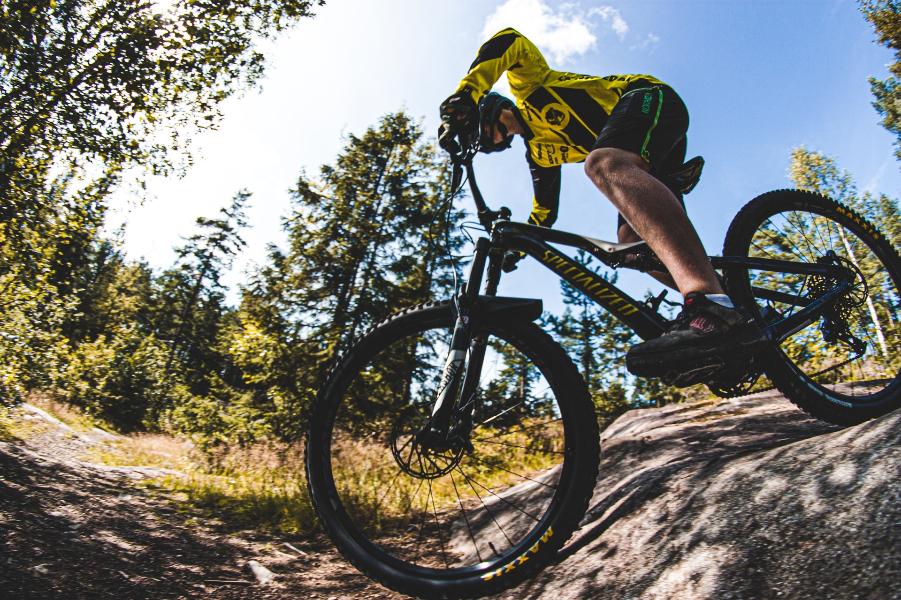
Photo Courtesy: Tobias Bjerknes/Unsplash
Another California invention, the mountain bike, first appeared in the 1970s but wasn’t mass-produced until 1981. The mountain bike’s intended use was for off-pavement or bumpy surfaces found during off-roading.
It was a quick success, as it encouraged urban dwellers to escape their surroundings and inspired other extreme sports. Mountain bikes had a more upright seating position and better front and rear suspension.
The European Bicycle Market: 1970s – 1990s
The British utility roadster was declining in popularity in the 1970s as recreational cycling became more popular. Now, lightweight bikes that weigh less than 30 pounds were the most affordable sportbike on the market and were also used for racing.
Swedish manufacturer Itera invented a bicycle made entirely out of plastic, but it failed. Instead, the U.K. switched from road-only to all-terrain bicycles. Mountain bikes were incredibly popular because of their versatility. By 1990, the roadster was practically dead.
Developments in the E-Bike Sphere: 1990s – 2000s
Unlike the traditional bike, the history of the e-bike spans only 40 combined years. Recently, e-bikes have exploded in popularity because of their lower price and accessibility. Yamaha built one of the earliest prototypes in 1989, which looks very similar to the modern e-bike.
Power controls and torque sensors were developed in the 1990s, while Vector Service Limited created and sold the very first e-bike called Zike in 1992. It included a NiCd battery that was built into the frame and included an 850 g magnet motor. However, there were barely any available, and it isn’t clear why. It may be because they were expensive to produce.
Yamaha invented the first pedal-assist system in 1993. On the other side of the world, American car icon Lee Iacocca founded EV Global motors in 1997. EV Global produced an e-bike named E-bike SX, and it was one of the earliest efforts to popularize the concept.
Bulky e-bikes at the time had lead-acid batteries, while new models adopted NiMH, NiCd, and lithium-ion. Lithium-ion was one of the most important breakthroughs in e-bike technology because it helped to increase the speed and range of the vehicle.
Modern Day E-Bikes and Their Surge in Popularity
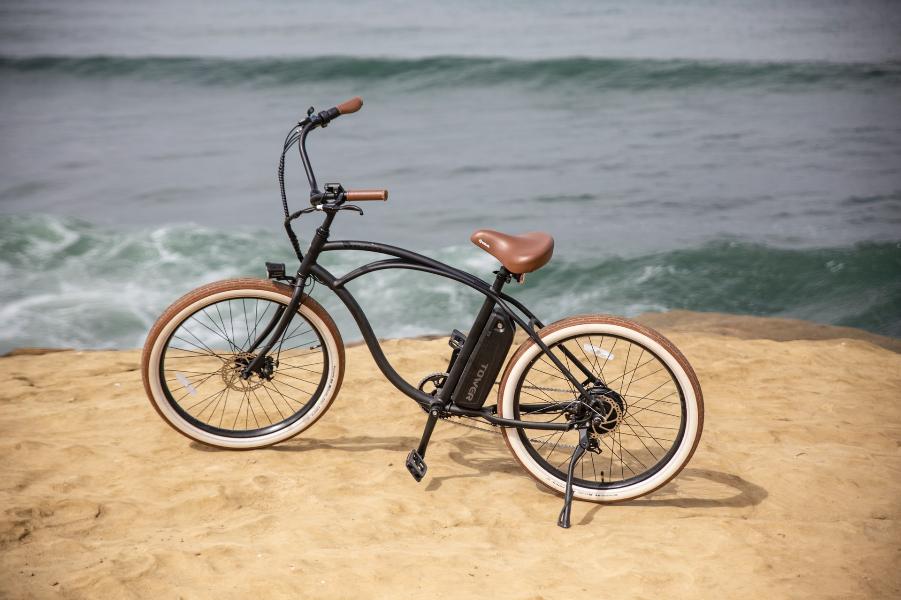
Photo Courtesy: Tower Electric Bikes/Unsplash
In 2001 electric bicycles were popular enough to have nicknames such as pedal-assisted, pedelec bikes, power bikes, and power-assisted bicycles. Now, the term e-motorbike or electric motorcycle refers to models that exceed 50 mph (80 km/h)
In 2007, e-bikes were thought to make up 10 to 20 percent of the market, while now they make up about 30%. A typical unit has an 8-hour charge battery, an average range of 15-25 miles, and can hit speeds of 20 mph (36 km/h).
There are currently multiple classes for e-bikes, including class 1, class 2, and class 3, which each determines where you can ride them and whether or not you need a license. Although this is implemented in Europe, these laws only exist in a few US states.
The Popularity of the Modern E-Bike
Since 1998, e-bike usage has seen rapid growth. China is the world’s largest producer of e-bikes, according to data from the China Bicycle Association. In 2004, China sold over 7.5 million e-bikes worldwise, which doubled from the previous year.
There are over 210 million electric bikes used daily in China, which is said to increase to 400 million in the next 10 years. In Europe, over 700,000 e-bikes were sold in 2010, but that number rose to 2 million in 2016. Now, the EU has implemented a 79.3% protective tariff on imported Chinese e-bikes to protect EU producers who seek to keep Europe as a primary market.
Are you an e-bike enthusiast?
Are you interested in many other articles, like this one, that gives an in-depth history of bicycle history?
Browse the site for more information on the best electric bikes and scooters that can make your commute more stylish and fun.
Before you go, leave a comment on what you think about the history of e-bikes and bicycles in general, or read one of our other articles about e-bikes.
The post The History of Electric Bikes and the Bicycle appeared first on eRide Guides.
]]>The post The Best Electric Scooters For Under $500 appeared first on eRide Guides.
]]>Not only will you see your monthly gasoline bill take a refreshing plunge, but you’ll also discover that e-scooters can be a lot of fun!
But what if you want to get into the e-scooter scene without breaking the bank? Never fear, for you’ve come to the right place.
These days, there are several electric scooters on the market that you can buy for less than $500. Whether you’re looking for an electric scooter that’s easy to transport onto buses and subways or even a scooter with its own cargo area, we’ll take you through some of the best electric scooters for the money.
We’ll even give you the down-low on the best e-scooter for kids so that the whole family can take to the streets for weekend rides.
So, without further ado, let’s dive in and help you find the perfect e-scooter for you!
GoTrax XL Elite
Price: $399
If you’re looking for a reliable e-scooter at an affordable price, then check out GoTrax.
GoTrax has established itself as a top brand by producing electric scooters that are more about function than bells and whistles.
The brand offers a wide array of e-scooters for under $500, and the new XL Elite is currently one of our favorites.
![Photo Courtesy: [Amazon]](https://erideguides.com/wp-content/uploads/2020/08/49180-1597115548763.jpg)
Photo Courtesy: [Amazon]
It also comes with safety features such as a super bright headlight, LED taillight, and six reflectors that will make sure you stay visible on the road.
It’s also foldable, which makes it easy to slip under your desk at work for added anti-theft protection.
With a dual braking system, an anti-slip 6.6″ deck, and a max weight of 220 lbs, the XR Elite is a solid choice for the urban commuter looking to scoot around those pesky traffic jams.
Pros:
- Up to 18.6 miles per charge
- Waterproof
- Relatively lightweight (31pds) and foldable
- LCD Display
Cons:
- No suspension
- Not as many features or as much power as more expensive scooters
Macwheel Electric Scooter MX1
Price: $399.99
If you’re looking for a hassle-free electric scooter with a little extra power, then check out MacWheel’s MX1.
It’s powerful 350W hub motor partners with a 270Wh lithium-ion battery to tackle slopes and other obstacles more reliably than your standard 250W motor e-scooter.
With a max speed of up to 15.6, it can take you up to 18.6 miles on a single charge, which is pretty respectable for a scooter in its price range.
![Photo Courtesy: [Machwheel]](https://erideguides.com/wp-content/uploads/2020/08/49177-1597115184444.jpg)
Photo Courtesy: [Machwheel]
You’ll also enjoy the reliability of front anti-lock and rear disc breaking for a smooth ride with dependable stopping power.
Weighing in at 28.25 lbs, the MX1 is not too much of a hassle to transport and is capable of supporting riders up to 256 lbs.
Pros:
- Shock absorption
- Puncture-proof/ air-free tires
- Dual braking system
- Lightweight enough to be portable
Cons:
- Fairly short deck
- Top speed is hard to achieve unless going down a hill
Glion Dolly
Price: $429.99
If your commute consists of buses, trains, or other public transportation, then the Glion Dolly comes with a bonus feature that you’re going to love.
Not only is it foldable, but it’s also equipped with a convenient pull-out handle that allows you to roll it just like a suitcase.
![Photo Courtesy: [Amazon]](https://erideguides.com/wp-content/uploads/2020/08/49181-1597115867271.jpg)
Photo Courtesy: [Amazon]
Keep in mind; however, that range will change depending on things like speed, terrain, and rider weight. While it can carry riders up to 255 lbs, some heavier riders have reported getting closer to an 8-mile max range.
With a max speed of 15 mph, it’s a nice little ride that can get you around town without becoming a burden to carry.
It also comes with a front headlamp and rear taillight for visibility, as well as electric anti-lock breaks and a foot-activated rear fender foot brake.
Overall, if you’re looking to cut down on long walks to the bus station or a fun little scooter to zip around the park on, it’s a reliable option that’s super easy to transport.
Pros:
- Carry-handle for rolling-suitcase style transport
- Smooth acceleration
- Dual braking system
- Sturdy and adjustable
Cons:
- Fairly small deck
- Doesn’t have a huge range, better for shorter commutes
- Not great with hills
Razor EcoSmart Metro Electric Scooter
Price: $469.99
Razor took things in a cool direction with their EcoSmart Metro Electric Scooter by providing both standing and sitting ride options.
Designed for short commutes, the Metro Scooter comes with both a bamboo standing deck and an adjustable bicycle seat for the days when you want to take a load off.
![Photo Courtesy: [Razor]](https://erideguides.com/wp-content/uploads/2020/08/49182-1597115994847.jpg)
Photo Courtesy: [Razor]
Capable of zipping along at up to 18mph, the Metro Scooter has a battery life of about 40 minutes per charge when used continually.
Designed for a max load of 220 lbs, it also comes with its own rear luggage rack and basket that are perfect for transporting school books or groceries.
If you’re looking to cut down on your commute time, environmental footprint, or both, the Ecosmart Metro Scooter is a great way to do it.
Pros:
- Soft, adjustable seat
- Luggage rack and basket
- Variable-speed, high-torque motor
- Retractable kickstand
Cons:
- Designed for shorter trips/commutes
- Not great with hills
- Rear disc braking system, can be a little tricky when going downhill
Levy Electric Scooter
Price: $499
Not only is the Levy Electric Scooter pretty cool looking, but it was also the first consumer-grade electric scooter on the market to boast a removable battery pack.
The 350W front motor works with a 230wH Panasonic Battery that can be removed and swapped out in seconds.
Not only is it nice to be able to carry a spare battery for longer trips, but it’s awesome to be able to charge your battery even if it’s not still attached to your scooter.
![Photo Courtesy: [Levy]](https://erideguides.com/wp-content/uploads/2020/08/49183-1597116136715.jpg)
Photo Courtesy: [Levy]
That said, if you’re looking for a scooter for short commutes or errands, then this is a cool one to check out.
It comes with cruise control, various riding modes, and regenerative front/ mechanical rear braking. At 27 lbs, it’s lightweight enough to make for easy transport and folds up easily for secure storage.
The Levy Electric Scooter can also hustle you along at up to 18 mph and boasts pretty solid acceleration capabilities for a scooter in its price range.
You can also choose from tubeless or tubed tires and a variety of different color schemes.
Pros:
- Removable batteries
- Top speed of 18mph
- 350W motor
- Cruise Control
Cons:
- Underwhelming single-battery range
- Second battery not included
Razor Power Core E90 Electric Scooter (Kids)
Price: $139.99
Looking for a scooter that will allow your kids to ride alongside you? If so, then Razor (a brand they may already be familiar with) is a great place to start.
Razor offers a variety of different kid-sized electric scooters, with their Power Core E90 Electric Scooter being among the most popular.
What really sets it apart from the rest is an impressive range. The Power Core E90 can last for up to 80 minutes of continuous use on a single charge, as opposed to other Razor scooters that top off at 40 minutes.
![Photo Courtesy: [Razor]](https://erideguides.com/wp-content/uploads/2020/08/49178-1597115327698.jpg)
Photo Courtesy: [Razor]
It’s driven by a 90W rear-wheel hub motor with a push-button throttle and hand-operated braking system.
The Power Core E90 weighs in at around 21 lbs, so it’s heavy enough to provide reliable traction while remaining totally manageable for a child to operate.
Recommended for ages eight and up, it can support up to 120 lbs of weight and is a great way to encourage your kids to spend more time outside and less in front of the TV.
Pros:
- Top speed of 10 mph
- Up to 80 minutes of continuous use per charge
- Air-less, flat-resistant back tire
- Push-button throttle
Cons:
- Charge time can take up to 12 hours
- Visibility reflectors sold separately
- Not foldable
If you liked what you learned here, then be sure to share it with your friends! And as always, feel free to reach out with any questions or comments that you might have!
In the meantime, feel free to peruse our other articles for answers to questions such as: How far can an electric scooter go on a single charge? or Electric scooters for beginners: Everything you need to know before you buy.
The post The Best Electric Scooters For Under $500 appeared first on eRide Guides.
]]>The post How Far Can An Electric Scooter Go On A Single Charge? appeared first on eRide Guides.
]]>For good reason!
They’re compact, environmentally friendly, and don’t require as much work as riding a traditional scooter.
Running on batteries instead of gas, electric scooters are perfect for those who want a more cost-effective way to travel. However, some may wonder about the basic information behind these scooters.
That includes one very important question:
How far can an electric scooter go on a single charge?
This post will break down how electric scooters work, how long it takes to charge, mileage, and some of the best electric scooters you can check out for purchase right now.
How Do Electric Scooters Work?
A traditional scooter requires the occasional “kick, push” method with riders using their leg and foot to get momentum on the scooter.
That momentum will eventually run out, though, and riders will have to use their leg and foot again to move the scooter forward.
Electric scooters, just like electric bikes, run off of battery power so there isn’t as much work required by the rider.
![Photo Courtesy: [Mearth Technology/Pexels] woman holding an electric scooter](https://erideguides.com/wp-content/uploads/2020/08/2-escooter-1597192827528.jpg)
Photo Courtesy: [Mearth Technology/Pexels]
The Motor Propels The Scooter
The electricity from the battery is transmitted back to the motor, allowing the scooter to move on its own.
Based on the type of scooter purchased, the motor will either make the front wheel or both the wheels rotate to push the scooter forward.
Rechargeable Right From Home
As previously mentioned, the electric scooter, like an electric bike, runs off of battery power. These batteries are rechargeable right from your home through any power outlet.
Some e-scooter models have built-in batteries where you’ll plug the accompanying charger right into the scooter. However, most models have removable batteries that come with an LED indicator light to detect the charge level.
Standard Speeds
The standard speed for a typical e-scooter is normally around 20 miles per hour, the top speed that can be used in the bike lane.
However, with recent changes in technology, more models are able to go up to 30 miles per hour.
For additional speed, you would need to purchase an electric scooter that resembles a gas-powered one with a full seat and deck to rest your feet. Those types of e-scooters can go up to 40 miles per hour.
How Far Can An Electric Scooter Go On A Single Charge?
You can always charge electric scooters on the go but you should know how many miles you can travel on the road between those charges.
Depending on the model, electric scooters can go up to 35-40 miles on average without charging.
However, other variables factor into how long your battery charge will last based on how much energy your scooter will be expending.
-
Weight
Weight is a significant factor in how much energy your e-scooter will use.
The weight of the scooter itself, the weight of the rider and any additional cargo will impact how much work the scooter has to do. The total amount of weight can decrease the range of the battery.
-
Terrain
The terrain where the rider goes on an electric scooter will factor into how much of the battery is used and how quickly.
Riding an electric scooter up a steep hill or other rough terrains will put more work on the e-scooter and, therefore, the battery.
If your ride is fairly smooth, you have a higher chance of the battery’s charge lasting a bit longer.
-
Speed
Another factor is the average speed that the rider is going.
Again, if a rider goes at the maximum speed of the e-scooter, that will impact how much energy the scooter is using and how quickly the charge will decrease.
-
Condition Of E-Scooter And Battery
Another important factor in how far the battery will take a rider is the condition of the battery and e-scooter themselves.
Researching good battery manufacturers will help you to find batteries that will last longer and give you a better range out on the road. A great motor matters in this regard as well.
Other things that will impact your ride and the overall charge of the battery includes the quality of your tires and the tire pressure.
Types Of Batteries That E-Scooters Use
Each e-scooter charges and travels differently based on the type of battery it uses.
Some of them take only 2-4 hours to fully charge while others may take 7-12 hours, all due to the battery. Below is a chart that breaks down the pros and cons of each.
| Battery Type | Pros | Cons |
| Lithium-ion battery |
|
|
| Lead acid battery |
|
|
| Nickel Cadmium battery |
|
|
Charging Tips For Your E-Scooter
- You can charge your electric scooter directly after a short ride. However, if your ride was longer, you had a long ride, let the battery cool down for about 30 minutes and then charge it.
- Do not leave your e-scooter’s battery without a charge for too long. Three months without a charge will wear down the battery. It is suggested to charge it at least once every 30 days, even if you don’t ride it as often.
- Use the original charger that is designed for your electric scooter. Do not try to use knock-off chargers that could end up damaging or overheating the battery.
- When charging, store your scooter or battery away from other items and potentially flammable materials.
- Regularly check the charger that comes with your electric scooter for damage to the cord or the plug.
Considering Long-Range Electric Scooters
If you plan to ride an electric scooter into work, around your city, or across other long distances and are looking to get the most bang for your buck, you may want to consider purchasing a long-range e-scooter.
Long-range electric scooters can travel up to 70 miles, providing users with a longer ride time without having to be charged as regularly as normal e-scooters.
Depending on the model and range of the e-scooter, long-range scooters can be a bit pricey but they are certainly worth the investment.
Below is a breakdown of some of the best long-range electric scooters out on the market right now!
| Scooter Name | Price | Specs | Pros | Cons |
| GOTRAX GXL | $299.99 |
|
|
|
| Segway Ninebot ES4 | $769 |
|
|
|
| Zero 9 Electric Scooter | $1,099 |
|
|
|
| EMOVE Cruiser | $1,399 |
|
|
|
| Kaabo Wolf Warrior 11 | $3,199 |
|
|
|
If you live in a metropolitan city or a safe area to ride electric scooters, you should definitely consider purchasing one.
They are environmentally friendly, less work to ride than a regular scooter, and take up less space on the road.
And, most of all, they’re fun to ride…even if you are commuting in for another dreary day at work!
As long as you keep these facts and tips in mind for your e-scooter’s battery, you should be able to maintain your scooter for the long haul.
Thank you very much for taking the time to read this article.
We hope that it has been beneficial in learning more about electric scooters and the batteries that help power them.
Before you go, be sure to leave a comment you have on the information you read.
You can also check out some of our favorite electric bikes and get more information on how much of a charge they typically get as well.
The post How Far Can An Electric Scooter Go On A Single Charge? appeared first on eRide Guides.
]]>The post The 4 Best Electric Scooters for Cities appeared first on eRide Guides.
]]>While some may hail trains or buses during the packed rush hour, you may find yourself too close to the other stressed or pedestrians that dread their workday.
For some, walking or biking is the alternative choice, but consider an e-scooter for your daily commutes instead. Electric scooters are compact, stylish, and are a cost-effective and easy way to go to work without the need to park.
Also, unlike traditional biking, running, or walking, the e-scooter does all the work so you won’t arrive at your destination all sweaty.
Since most electric scooters come packaged with a rechargeable battery, you can charge it daily and be ready for the workday.
The following e-scooters can cruise at 15 mph, are lightweight, and some are capable of folding. Perfect for city commutes!
Our Top Picks
Out of the four e-scooters on this list, I would recommend the Turboant X7. Not only is it reasonably priced for all its features, but it’s the ability to scale hills with a 15° slant, it’s high top capacity limit, and intuitive LED display make it unique in comparison to the rest on this list.
I also had the most fun with the X7 while riding to work.
Best Electric Scooters for Cities
Turboant X7 Commuting Electric Scooter

Photo Courtesy: Turboant
Features:
- Powerful 350-Watt Motor for High Speeds
- Detachable Long-Range Battery
- Comfortable Riding Experience
- UL Approved
- Portable and Foldable
The X7 from Turboant is an impressive scooter that boasts several remarkable features. The uniquely detachable long-range battery is made out of lithium-ion, one of the most long-lasting battery materials for e-scooters and e-bikes.
As an additional bonus, its battery is covered by Product Liability Insurance, so you won’t have to worry about faulty components while purchasing online.
Since the battery is detachable, you can charge it anywhere without bringing along your e-scooter – even in a small area. The Turboant X7 can travel up to 26 miles (41 km) on flat terrain on a full 4-6 hour charge.
The 350 W electric hub motor allows you to hit speeds of 20 mph (32 km/h) or more, scale hills with a 15° slant, and contains 3-speed settings.
Large 8.5″ tubeless pneumatic tires are anti-puncture, fuel-efficient, and absorb a large amount of shock on uneven roads. If you want to keep your max speed, turn on the cruise control to coast on the sidewalk.
With a triple braking system and LED lighting, you can safely cruise at night and feel confident your e-scooter will stop at high speeds.
As a plus, the design is portable and foldable. Although it’s aluminum alloy frame is rust-resistant and sturdy, this time-saving device only takes 3-seconds to fold in half.
The Turboant X7 can support a max load of 275 lbs, which is significantly higher than other e-scooters on the list. Finally, this model is certified by UL LLC, a global independent safety science company, to ensure its safety and reliability.
Overall, I was impressed with what the X7 had to offer, especially for the budget price of $400 or less.
The Turboant X7 even has a LED display to see your battery charge and speed. The abundance of features makes the Turboant X7 feel like a bargain.
GOTRAX GXL V2 Commuting Electric Scooter
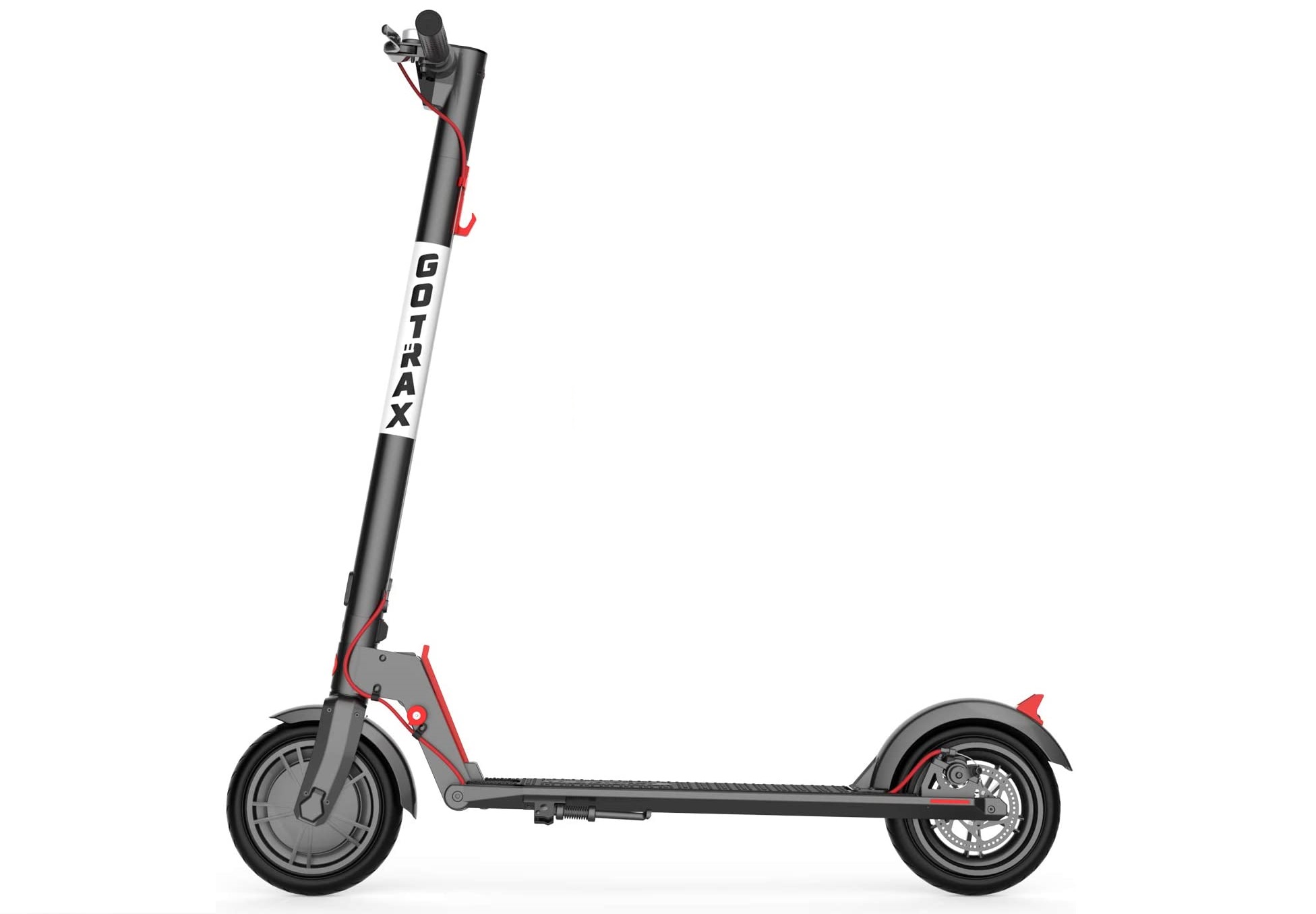
Photo Courtesy: GOTRAX/Amazon
Features:
- Acceptable 250 Watt Motor
- 36 V Battery with a Long Charge
- Multifunctional Display
- 8.5″ Pneumatic Tires
- Portable and Foldable
The GOTRAX GXL V2 is a long-range scooter that has a lot of features. Its high capacity 36V/5.2 Ah battery has a maximum range level of 10 – 12 miles on flat terrain.
A commuting scooter has to have a fast charge, and the GOTRAX GXL V2 is no exception. Plugin your scooter overnight, and within 4 hours, you’re ready for your next ride to work.
For as little as $400, you get a strong e-scooter that features a 250W motor and a top speed of 13.5 – 15.5 mph in ideal conditions.
Although the GOTRAZ GXL V2 doesn’t have as high of a capacity limit as the Turboant X7, it can still handle a max load of 220 lbs. It can also tackle steep and small hills with a 10° slant.
Some of the best commute scooters are foldable, and the GXL V2 delivers on that promise. It’s equipped with a one-step folding system that takes 3 seconds.
The aluminum alloy material helps to enhance stability while making the frame lightweight for carrying. A Red Safety Button prevents the handlebars from folding in on themselves while you ride.
The front and rear wheels use 8.5″ pneumatic tires to protect against bumpy terrain while increasing the frames’ overall durability.
With its disc brake and anti-lock braking system, you can bet the GXL V2 is responsive at high speeds.
Finally, it’s LED display provides important information like speed, battery life, and headlights (which are visible up to a 26 feet irradiation).
I was happy to ride the GXL V2 because of how compact, tiny (small enough to fit under a desk), and fast it was.
I felt like a speeding bullet down the sidewalk. Take some stress out of your morning and invest in this e-scooter – you won’t be disappointed.
Segway Ninebot ES2 Folding Electric Kick Scooter
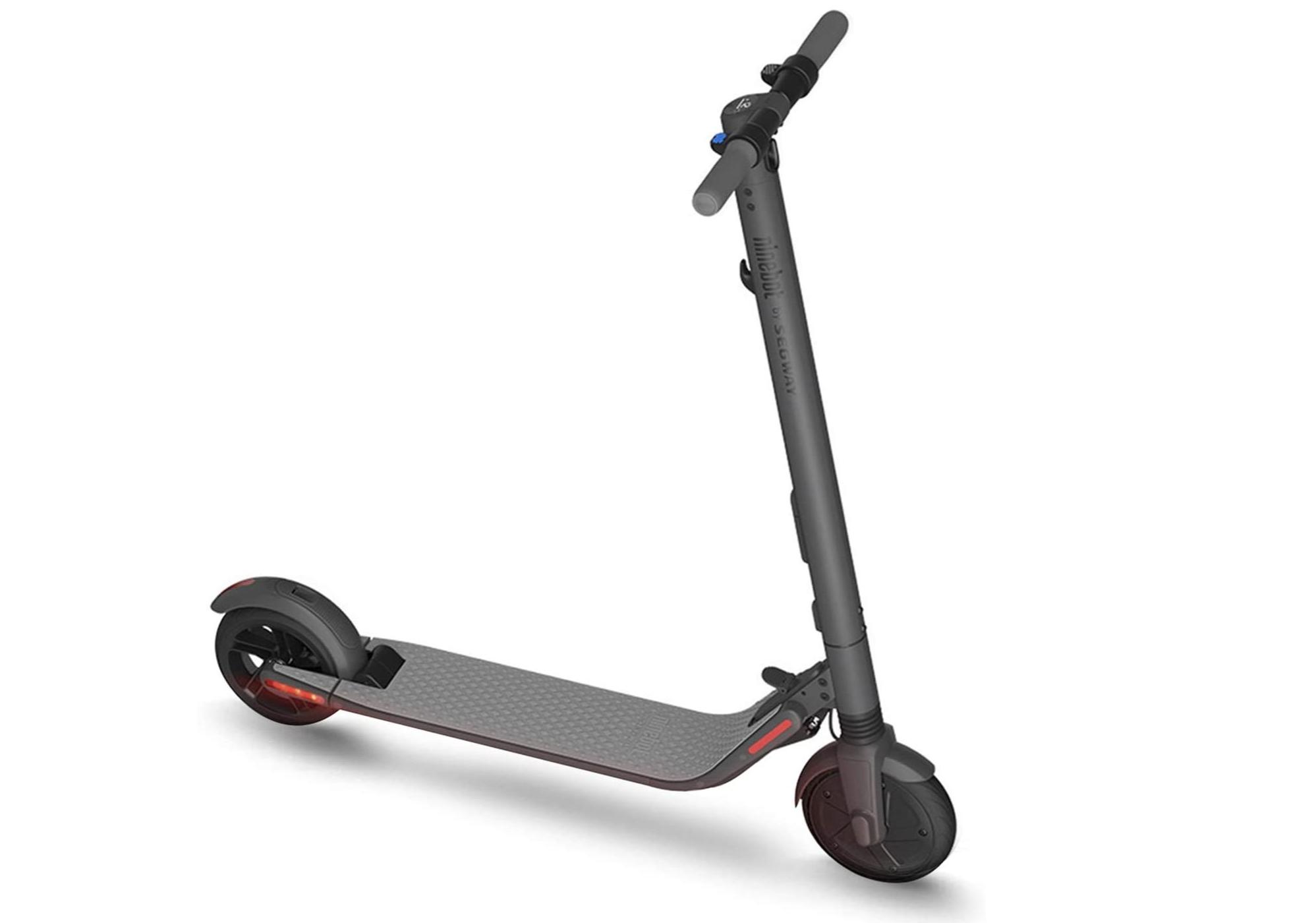
Photo Courtesy: Segway/Amazon
Features:
- Impressive 300-Watt Motor for Long Distances
- Super long 15.5-mile range
- Dual Suspension System
- Bluetooth and Mobile Connectivity
- Lightweight and Foldable
The Segway Ninebot ES2 is the perfect e-scooter for long distances. Thanks to its impressive 300 W motor, the ES2 can hit a top speed of 15 mph (25 km/h) and can travel 15.5 miles on flat terrain.
From reading customer comments on Amazon, I’ve noticed that many buyers have clocked in over 20 miles (32 km) on one charge.
Super compact, lightweight, and foldable at only 27.6 lbs, the one-click folding system takes seconds. It’s possible to carry the ES2 with one hand – making it the perfect traveling companion.
The solid, shock-absorbing tires and anti-lock braking system allow for a comfortable riding experience.
With the superior technology of the Segway Ninebot ES2, you can turn on its Bluetooth capabilities and connect to your phone to see your statistics in real-time.
This model also has cruise control, customizable ambient light colors, and additional security features that make updating the LED display safe and secure.
The only downside to this e-scooter is its price. Although this is an excellent e-scooter for long distances, you can tell that Segway is banking on its name recognition.
Still, buying from Segway means buying from a trusted brand so, the warranty, customer service, and support will be top-notch if you run into any problems.
With a climbing capability of 10° and 3.5-hour max charging time, it’s easy to overlook it’s $700 price tag.
I especially liked the app functionality, so I could easily customize or manage my rides if I wanted to maintain a certain top-speed.
Xiaomi Mi Electric Scooter
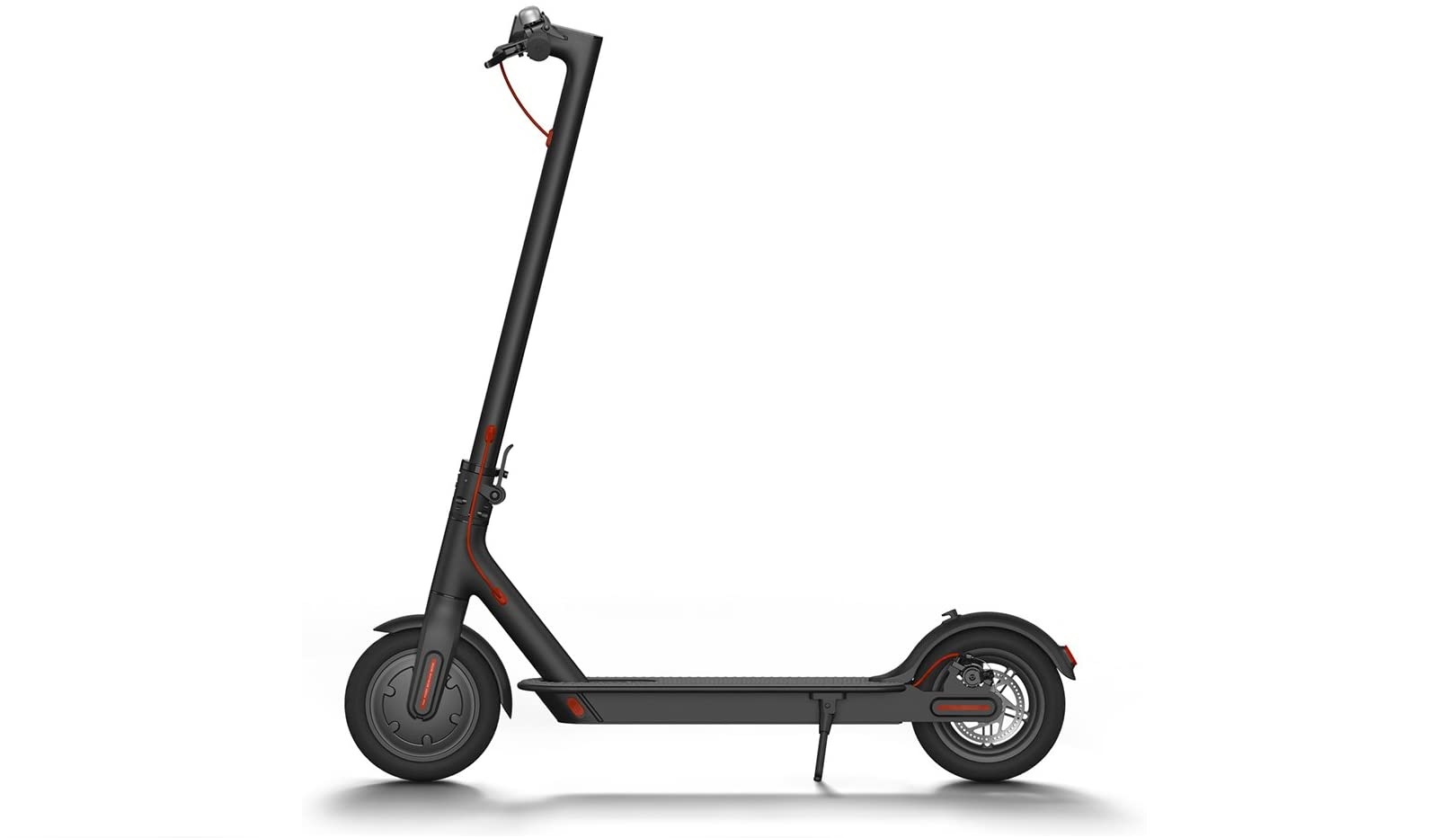
Photo Courtesy: Xiaomi/Amazon
Features:
- 250-Watt Motor and Decent Speeds
- Amazing 18.6-mile range
- Double Braking System
- Award-Winning Design
- Portable and Foldable
The Xiaomi Mi Electric Scooter has the most extended range in comparison to the rest of this list at 18.6 miles on flat terrain. The 250W motor propels this e-scooter at 15.5 mph (24 km/h), which is standard.
I have read that users have achieved 17 mph (27 km/h) speeds or higher, but while using it myself, I clocked out at 16 mph (25 km/h), which is still higher than advertised.
Perfect for commuting, the Xiaomi Mi weights only 26.9 lbs and folds in second for easy storage under your desk at work or within your home.
If you need to hand-carry it, you can do so effortlessly thanks to its sturdy, but lightweight aerospace-grade aluminum. It’s gun-metal and black coat of paint looks sleek and stylish.
With the double braking system of disc brakes and eABS regenerative anti-lock braking, you can feel safe knowing its responsive. No matter if you’re cruising or utilizing its max speed, it will stop on a dime.
Its anti-shock 8.5-inch wheels make riding comfortable, while its LED interface is easy-to-learn for all ages – including children.
The Xiaomi Mi Electric Scooter is the only e-scooter on this list to win multiple awards for its intelligent design. Both the prestigious Red Dot “Best of the Best” Award and the iF Design Award were awarded to the company for this scooter in 2017.
After looking up these awards, they’re quite prestigious when it comes to forward-thinking technology.
What really impressed me was that the front tire uses some type of regenerative braking that charges the battery. If you’re looking to commute in style, I would recommend the Xiaomi – especially for super long and hilly commutes.
Are you an e-scooter enthusiast?
Are you interested in many other articles, like this one, that compares and contrasts the latest e-bikes and e-scooters?
Browse our site for more information on the best electric bikes and scooters that can make your commute more stylish and fun.
Before you go, leave a comment on what you think about the scooters mentioned on this list, or read one of our other articles about e-scooters.
The post The 4 Best Electric Scooters for Cities appeared first on eRide Guides.
]]>The post Electric Bikes vs. Regular Bikes: The Differences Explained appeared first on eRide Guides.
]]>At first glance, they look very similar to each other but, upon closer inspection, you can start to see how the technology on the e-bike is just as different as it is similar to a regular bike.
To put it simply, an electric bike is a regular bike with an added drive system. The drive system consists of a motor, battery, and a way to steer the motor’s power into the drivetrain. Although the cost of an electric bike is similar to a regular bike, maintenance on an electric bike is often more expensive. However, the speed of a traditional bike is usually a lot lower for typical users.
Let’s take a closer look at the attributes that truly set the two bikes apart, including speed, rules and regulations, riding experience, appearance, and maintenance.
First, let’s look at the history of the traditional bike and its electric counterpart.
Over 200 Years of Bicycle History
Overview
In 2017 the bicycle celebrated it’s 200 birthday. The bikes’ impact on our culture and tradition is unprecedented because it created mobility where there previously wasn’t.
Although the automobile took a significant portion of the traditional bikes market share, it wasn’t until the e-bike that the regular bike saw a substantial cut in its profits.
With over one billion bicycles in the world, the traditional bike is the most common mode of transport worldwide by a large margin. The passenger car looks meager in comparison to only 500 million.
Looking at Germany, there are over 81 million bikes and only 45 million cars, with 3 million of those bikes consisting of electric bikes, scooters, or other electric assisted vehicles.
It’s easy to see why bikes have gained popularity in part of its mobility and economical design. The bicycle quickly replaced stagecoaches and turned nobility on its head.
No longer were the bourgeoisies the only class that could comfortably ride long distances. It’s likely that without the traditional bike, automobiles wouldn’t exist in their current form.
The Invention of the Traditional Bicycle
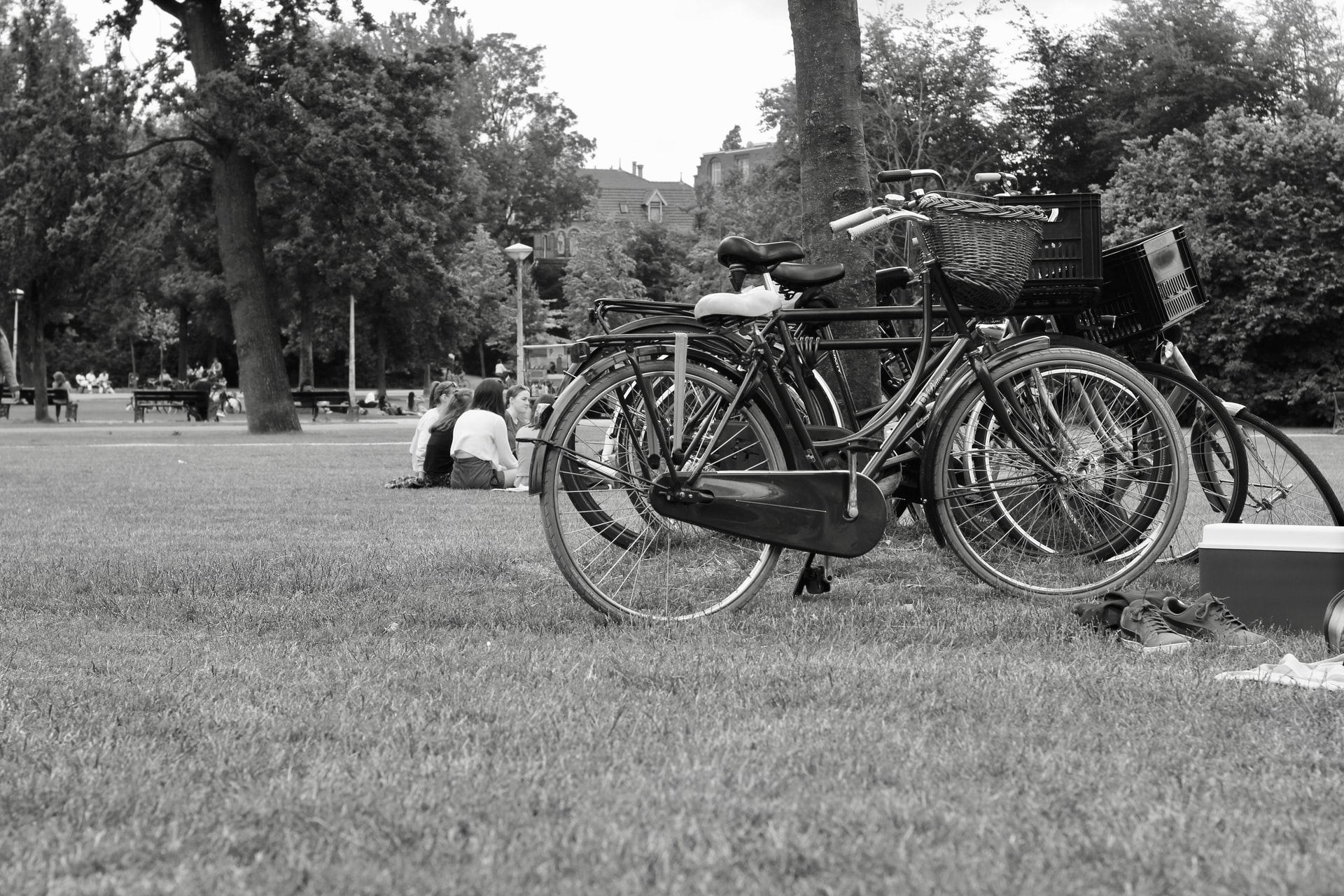
Photo Courtesy: Louis Hansel @shotsoflouis/Unsplash
The first bike prototype was called the running machine or dandy horse created in 1817 by Karl Drais. It had no pedals and could only propel with kicking the road beneath it. In 1860, the crankset and pedals were mounted on the dandy horse by Pierre Michaux. The first bicycle prototype, created by John Kemp, was built in 1885.
Visionary Robert Bosch and the Bosch group are responsible for many add-on inventions to the modern bicycle. In 1890, Robert Bosch popularized biking in Germany and the rest of Europe by riding a High-Wheeler, which had a large front wheel and a tiny rear wheel for stabilization. In 1903, the hub gear system invented by Erst Sachs was the first mass-produced part.
Back to the Bosch company in 1923, the invention of the dynamo lighting system produced over 20 million units by the 1960s and allowed commuters to bike at night.
The derailleur system, invented by Tullio Campagnolo in 1948, was a style-setting influence for years to come – even during the birth of the mountain bike in 1973.
In the modern area of 1993, Yamaha mass-produced the crank-drive pedelec motor to support and reinforce active pedaling.
Since then, inventions have been focused on e-bikes. Regardless of which bike is featured, Bosch has remained the European market leader in bicycles since 2013.
The Invention of the Electric Bicycle
Electric bikes don’t have as long as history as traditional bikes, but inventors have attempted to make e-bikes roadworthy since 1895, but it wasn’t possible until the modern era.
For one, the heavyweight of the electrically driven wheels coupled with the batteries’ low range made e-bikes useless until the invention of the lithium-ion battery in 1991.
It’s now possible to ride over 62 miles (100 km) on a single charge, and with the mass production of electric bikes, motors, and batteries, the technology is more accessible than it ever has been.
Pedelecs are actively shaping city landscapes and making us rethink how to use and maintain proper cities and transportation.
Technical Differences Between an E-Bike and Regular Bike
Electric bikes have electrical components, whereas a regular bike has mechanical components. They both work in similar ways, except the electric bike has the additional drive system, which consists of a motor, battery, a way to control the power, and a way to integrate said motor’s power into the drive train.
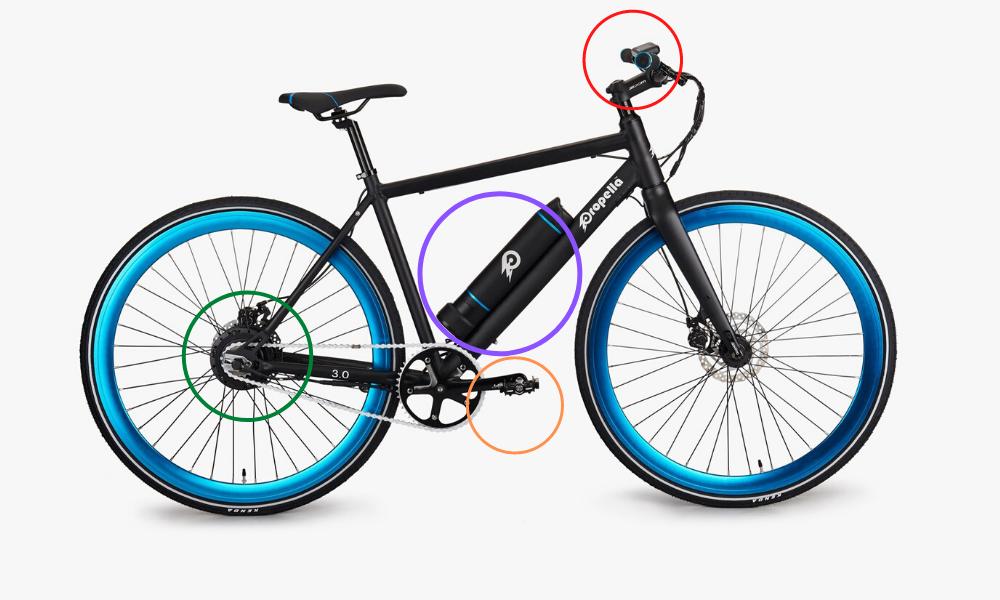
Photo Courtesy: Katrina Dent/Propella
Take a look at the Propella e-bike. It looks similar to a traditional bike, but the color circles indicate the electrical differences. The red circle highlights the throttle, the orange circle shows the mid-drive motor, the green circle is the drivetrain, while the purple circle is the battery that powers the motor in the rear.
Mid-Drive Motor
Although some e-bikes use hub-motors, the mid-drive motor was invented to improve on the short-comings of the hub-motor.
For one, mid-drive motors have a more significant gear ratio so that the rider can power the rear wheels with the same chain and gear set. Mid-drive motors are great for riding up steeper hills and are unlikely to overheat.
Weighing only 5 lbs, the mid-drive motor packs a lot of punch and acts as the motor to power the e-bike. Mid-drives allow for true torque sensors for pedal-assist systems (like the Propella) to regulate the motor power based on how hard you push.
Its center of gravity is close to the ground to improve handling while distributing the weight easier throughout the bike.
Battery
The most expensive and heavy component of the bike, the typical electric battery can provide up to 40 miles (64 km) of riding, but multiple factors determine the true scope, range, and power of the battery.
There are 4 common types of batteries on the market: lead-acid, nickel-cadmium, nickel-metal hydride, and lithium-ion.
Lithium-ion batteries are becoming the default battery because they produce more power output and weigh significantly less than the other options.
Most importantly, they’re durable and will last longer. Although this component is costly, it’s more than worth it because it knocks other batteries out of the park when it comes to range, weight, and longevity.
Drivetrain
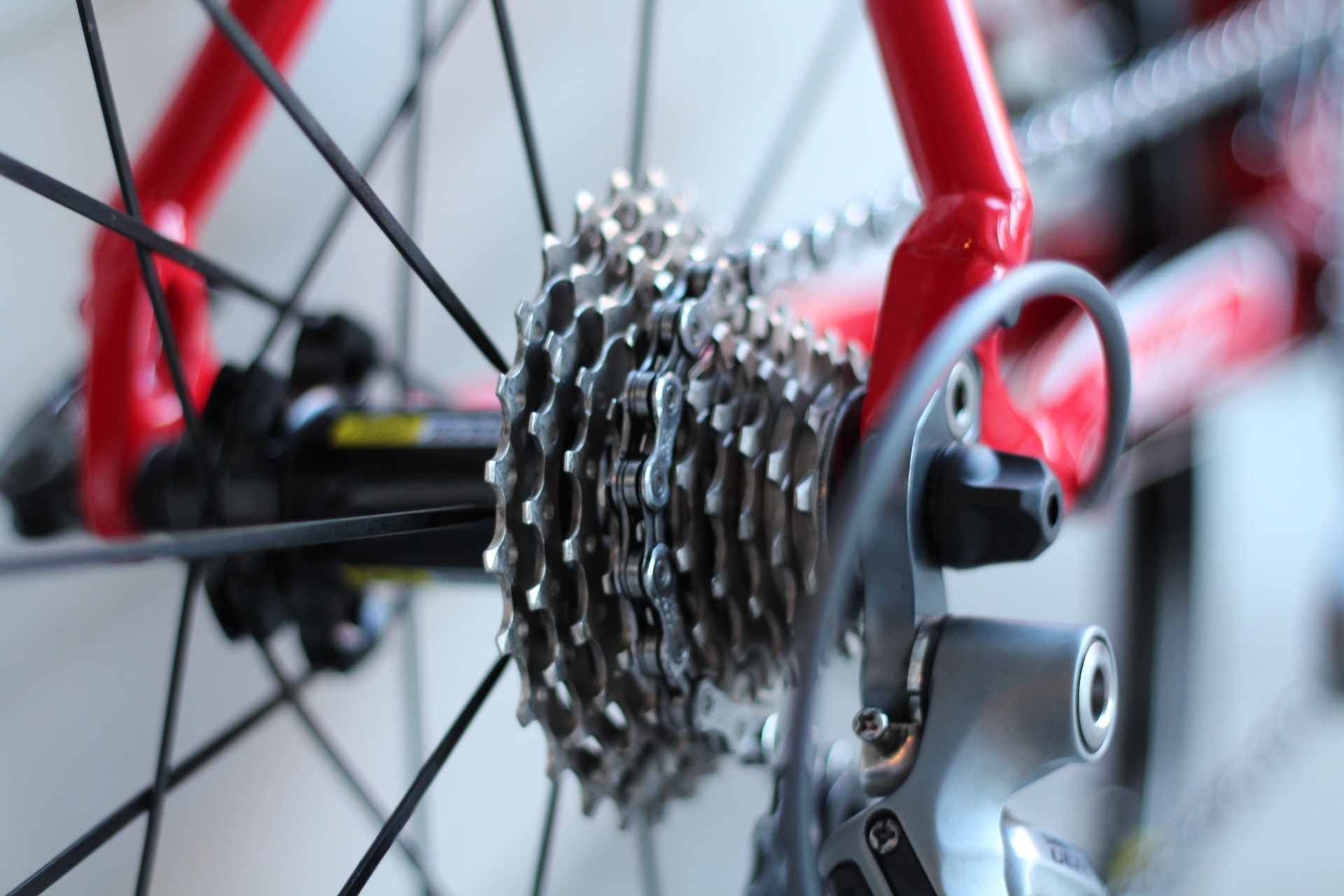
Photo Courtesy: Wayne Bishop/Unsplash
The drivetrain delivers power to the driving wheels and converts torque and speed via the gears. Many e-bikes on the market allow you to ‘turn up the dial’ to adjust the gears on the drivetrain, so you’re able to scale steeper hills.
To protect against accelerated wear on the drivetrain, the power in the motor is typically limited to around 250-500 watts.
A significant drawback of an e-bikes drivetrain is that it has to be charged (though not on a regular basis) while the traditional bicycle drivetrain doesn’t.
An uncharged drivetrain won’t be able to shift gears. As a benefit, the drivetrain, when charged, will remain consistent while switching gears because there are no cables that could slop or stretch over time.
Throttle
Most e-bikes have two modes: throttle mode and pedelec mode. Where the pedelec mode works similar to a traditional e-bike and uses pedals to propel forward, the throttle mode on an electric bike works identical to a motorcycle throttle.
The throttle engages the motor and provides power and moves you and the bike forward.
A throttle component allows e-bike users to sit back and let the bike do all the work. Some e-bikes allow for both the throttle and pedelec modes to engage at the same time.
This will enable commuters to go above the top speed of the bicycle while getting some exercise in the process. Not all countries allow for the throttle feature on bikes.
Except for the above 4 components, all other parts on an e-bike are the same as a traditional bike. E-bikes still have a frame, disc, brakes, two wheels, a seat, suspension, pedals (in most cases), and handlebars.
Electric Bike Display
It’s uncommon to find an electric bike with a display – especially if you’re riding anything under $1000. However, you can always buy an electronic bike display and hook it up to your battery and motor for accurate readings on the range, battery level, speed, distance, and trip distance. Traditional bikes hardly ever come with a display, and it typically isn’t as advanced.
More expensive e-bikes offer additional bike display features, such as tracking sat nav/GPS and fitness tracking. These displays can help you quickly interpret how many calories you’re burning in a session and location, as well as the overall health of your bike.
I recommend you purchase an e-bike with a display to better understand your e-bikes range, max speed, and battery level as it helps with general maintenance.
The Differences in Riding Experience
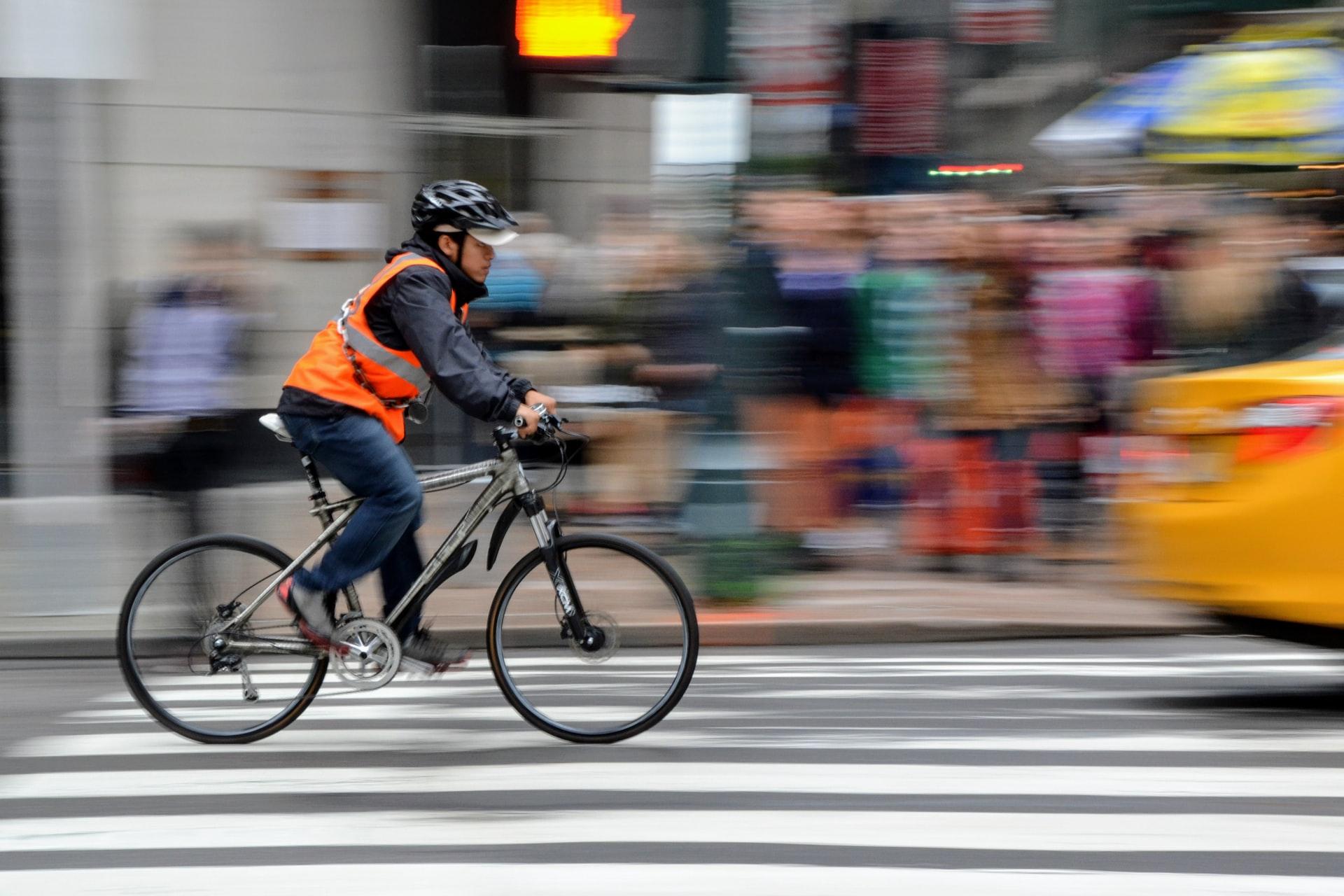
Photo Courtesy: Javier de la Maza/Unsplash
Although there aren’t many differences between an electric bike and a traditional bike, the riding experience can be vastly different. Whereas an e-bike commuter can choose not to use the throttle and ride it like a conventional, albeit a heavier bike, the traditional bike can only act as an ordinary bicycle and only use the pedals to propel itself.
The major shortcoming of a traditional bike is its accessibility. Maybe you want to be fit, but you’re not quite there yet. Perhaps you want to ride a bike to work to save on gas money, but you’re concerned about arriving to work sweaty.
Or, maybe a heart disease or other physical impairment prevents you from participating in a more active lifestyle.
The electric motor solves these problems. No matter how windy, how long, or how far your commute is, the motor will help you arrive at your destination.
If you want to bike, but halfway to your destination you’re exhausted, you can use the throttle to coast the rest of the way.
Riding a bike gives you the freedom to ride unencumbered by traffic or the size of the road. You also don’t have to worry about the price of gas (just electricity for an e-bike).
Electric bikes add that extra bit of freedom to all because it’s an accessible and fun activity.
Fitness vs. Convenience
Let’s get this out of the way: riding an e-bike, even one that isn’t pedal-assisted, isn’t cheating your health or fitness levels. The automobile was invented to solve the problem of a long-distance commute without the reliance on horses.
E-bikes fill that need for those who can’t afford cars in the big city while also providing a means of accessible transportation.
I’m a cyclist, but if I have to take a 40 mile (64 km) round-trip to a friend’s house or work, I reach for the car keys instead.
If I’m feeling tired, I’m more likely to use the path of least resistance, especially if the road ahead is hilly.
With an electric bike, I can make the same trip with minimal effort if I choose only to use the throttle. I can do errands easier, and quicker, because I don’t have to wait in traffic or find somewhere to park. It also saves me money on gas.
Instead of looking at a traditional bike vs. electric bike and riding vs. not riding, look at it as a fun, convenient, and accessible way to travel. With a pedal-assisted e-bike, I can also get my exercise in if I choose to.
Maintenance and Repairs
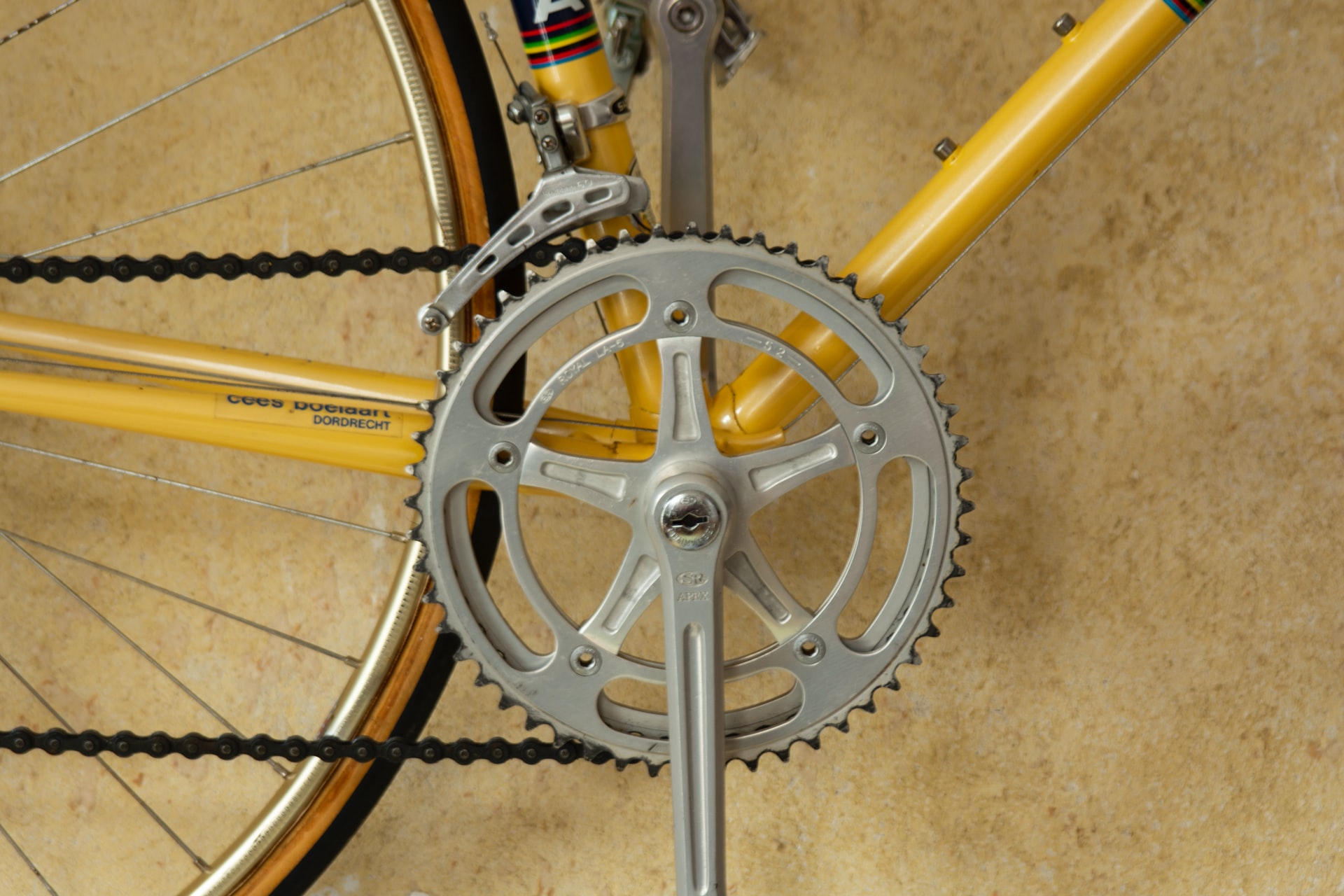
Photo Courtesy: Jeremias Radny/Unsplash
The traditional bike and e-bike require frequent maintenance, but the e-bike could cost more if the battery or motor is damaged. Overall, the cost of maintenance and repairs is similar.
Keep Your Bike Clean
Clean both your bike and e-bike regularly to maintain the look and overall health of your vehicle. Both the traditional bike and e-bike can use diluted dish soap and rags to wipe down the frame gently.
Try not to use soap or water on gears or other components that could rust, or they may erode and require a replacement.
While cleaning an e-bike, you will need to be more careful, or you risk damaging or destroying the electrical components. Always take the battery out, and clean carefully around the motor, battery container, and drivetrain.
Both the traditional bike and e-bike can be polished with a bicycle wax to add an extra layer of protection over the frame and paint.
Lubrication
To keep all gears in good working order, apply lubrication to the moving parts such as the chain and brake. Use a special cleaning solution to wipe off dirt or mud on these components before applying lubricant.
Both the traditional bike and e-bike need lubrication in the same locations once a week.
Inflate Tires
Both the traditional bike and e-bike need properly inflated tires at all times. It’s important to check tire pressure at least once a week and check tires for uneven wear or puncture holes.
E-bikes can come with airless tires, so tire pressure won’t be an issue in this case. However, it is still essential to check for wear on airless tires.
Check Brakes
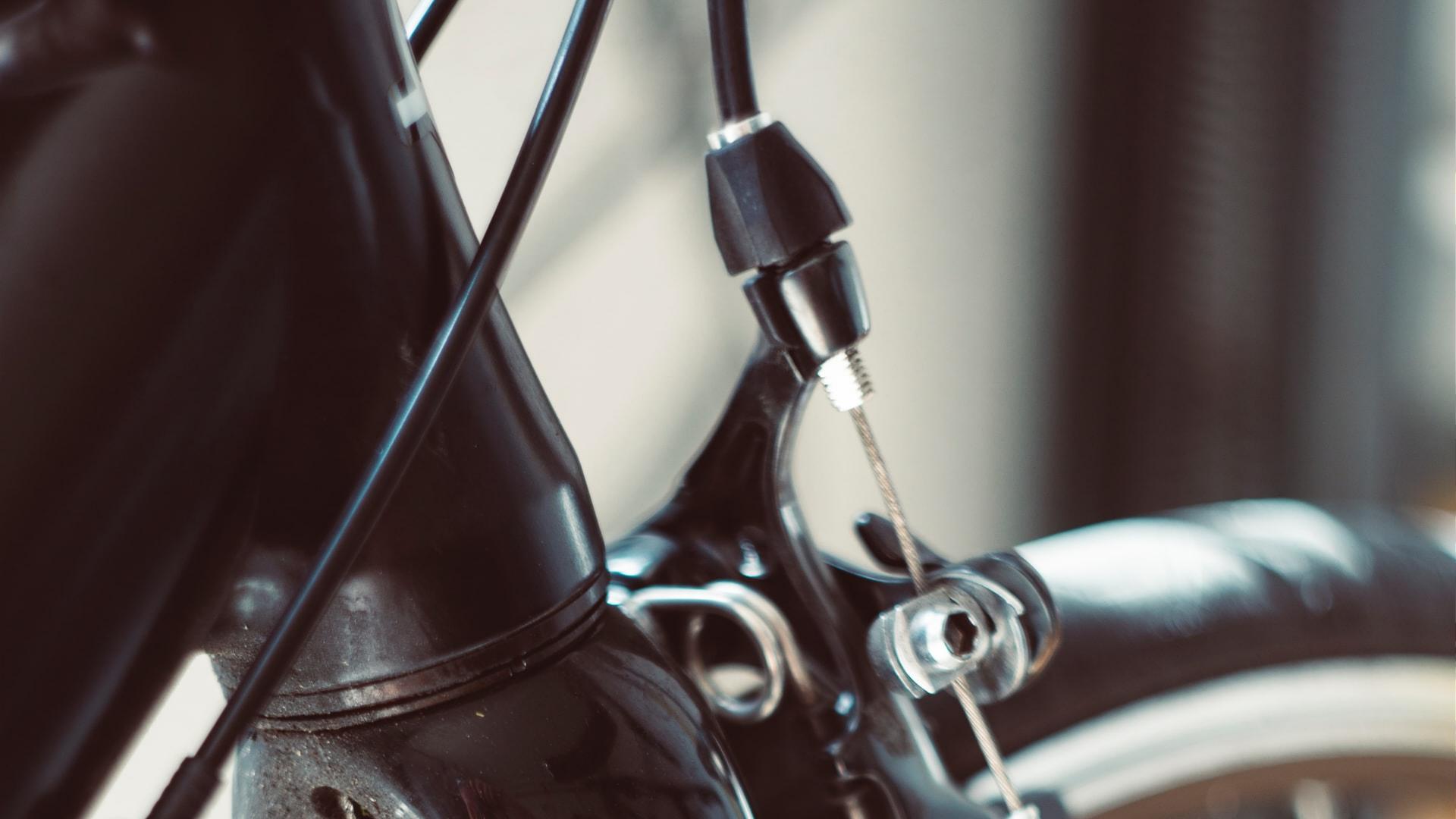
Photo Courtesy: Markus Spiske/Unsplash
On a traditional bike, the brakes are connected through a series of cables. Instead, an e-bike uses brake pads similar to an automobile to stop quicker at fast speeds.
For brake cables, check if there are any tears and that the connection isn’t loose or severed. For brake pads, check for wear and tear, and that the nubs on the pads aren’t too worn down.
To test either kind of brakes, ride at less than 8 miles (12 km/h) and pump the brakes. Notice how fast you stop and if you need to adjust the brakes stopping power.
It’s always better to test your brakes before riding (especially on an e-bike) to prevent potential accidents.
Tighten Nuts and Bolts
Every week, check all the nuts and bolts on your bike and tighten any that look loose. To quickly determine which nuts and bolts require tightening, use your fingers to try and loosen screws.
If they come apart easily, they are too loose and need a wrench to tighten them. Never use your fingers to tighten nuts, bolts, or screws because they won’t stay that way long-term.
Battery and Motor
Unique to the e-bike is maintenance on the battery and motor. Always read the manufacturer’s instructions to properly preserve both parts long-term.
Since battery and motor replacements are expensive, ensure that water, dirt, or dust doesn’t get inside its components. Always remove both parts during storage or in colder temperatures.
Average Speed

Photo Courtesy: Anthony Gilbert/Unsplash
As of writing this, the world record bicycle speed is 183.9 mph (295 km/h) broken by Denise Mueller-Korenek, 45, and with a draft provided by a dragster.
The average cycler doesn’t achieve speeds close to that at 9.6 mph (15.5 km/h) on a flat surface. A fit rider can maintain speeds of 25 mph (40 km/h), which is also the average speed of a moderately priced e-bike.
An e-bike, unless it’s rigged to do so, doesn’t exceed speeds of 40 mph (64 km/h) with a throttle. In the United States, an e-bike cannot exceed speeds of 28 mph (45 km/h) legally either on the sidewalk or street.
Although it is possible for a human-powered bicycle to exceed 28 mph and 40 mph, you cannot do so unless you’re exceptionally fit.
If you’re not racing, e-bikes might make your ride faster (and arrive at your destination less sweaty).
This is because the e-bike’s motor makes pedaling feel effortless so you won’t get tired as quickly. An e-bike also helps to maintain a constant speed.
Rules and Regulations
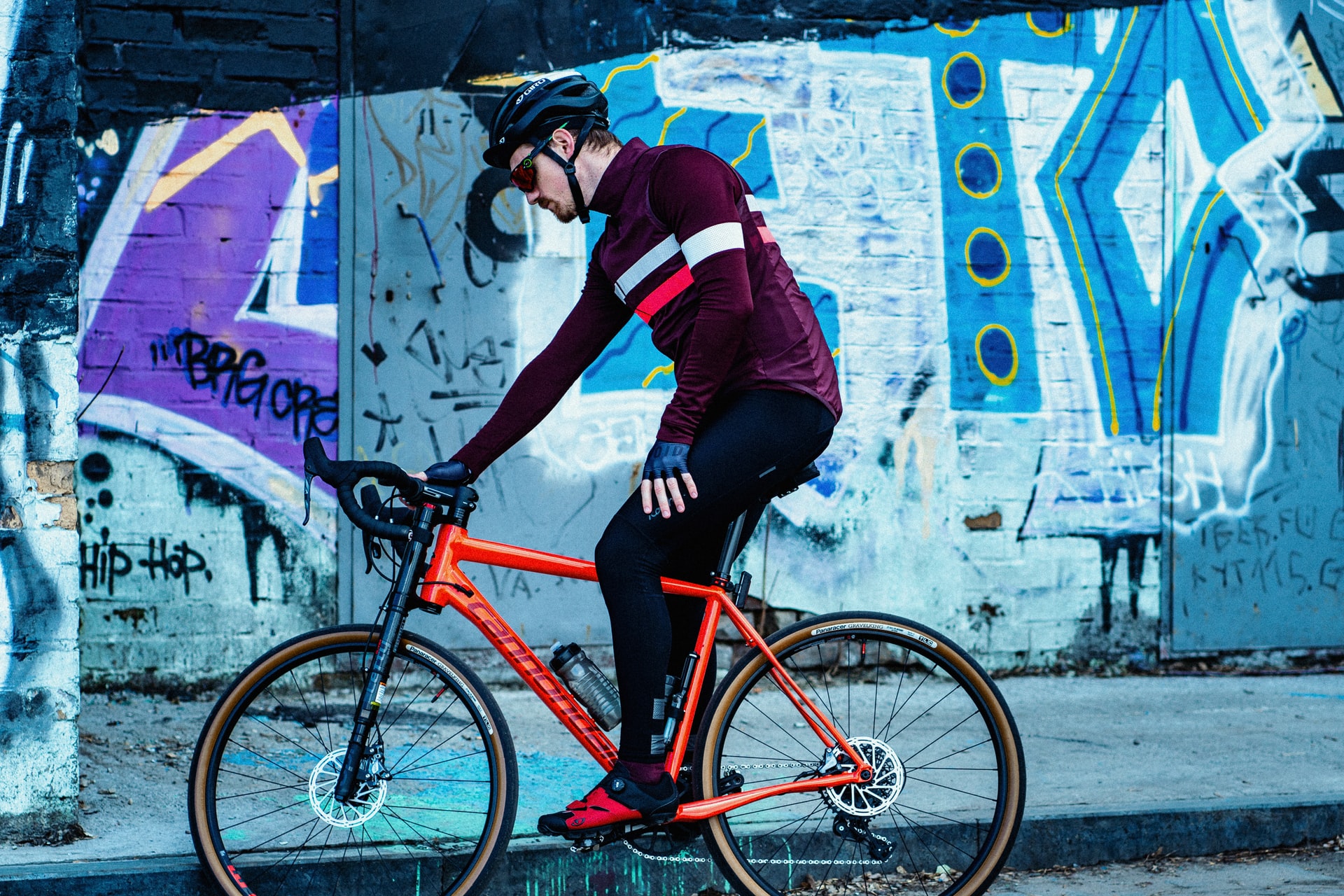
Photo Courtesy: Victor Xok/Unplash
Although there are rules and regulations for a traditional bike, these rules don’t carry the same weight if you break them compared to e-bikes.
Traditional Bike
In the US, all bicycles must have lights between sunset and sunrise to improve visibility and reflectors so other vehicles can see you. Brakes are also mandatory, but only one functioning brake is necessary for US bylaw.
The requirement to wear a helmet in the US varies based on jurisdiction and age, but it’s usually a good idea to wear on if you’re riding in traffic.
As a general rule in the United States, all bikes must ride on the right-hand side of the road and never against the traffic flow. You must occupy the same space as motor vehicles and never on the sidewalk unless there is a designated bike lane.
Since a bicycle is considered a slow-moving vehicle, you must position yourself as far right as possible so cars can pass you.
Hand signals are required to inform cars where you plan on turning. As an alternative, you can buy electronic signals or brake lights.
Breakings any of these rules usually results in a slap on the wrist (at most a ticket) unless you cause a significant accident.
E-Bike Regulations
E-bike regulations include bicycle bylaws but start to become more complicated depending on where you live. In most states, e-bikes are considered either motorcycles or slow-moving electric vehicles.
Some states, like California, have their own classification for e-bikes. As of writing this, there is only one US state that requires an e-bike license for operation (while other states either don’t require one or only accept another license like an M or Class 3).
Many states are looking to implement the 3 class system, which puts different e-bikes in 3 different classifications. Creating appropriate e-bike laws is a slow-moving process, but most states are starting to implement this system.
Since all e-bike regulations pass at a state level, the rules vary depending on where you live.
The minimum age of riding and the necessity for helmets is another contested topic. While some states require a minimum age between 14-18 to operate an electric bike, others have no minimum or distinction between class 3 bikes (any e-bike that can travel 28 mph (45 km/h).
Although helmets aren’t necessary to wear in all states, I recommend you wear one anyway!
Overall, e-bike laws are confusing in the United States, but are more straightforward in Europe and Canada as the requirements are consistent throughout their states and provinces.
Always check your state laws before operating an e-bike.
Are you an e-bike or bicycle enthusiast? What to read more about e-bikes and e-scooter? Stay on our website for more in-depth articles on electric transport.
Before you go, leave a comment on what you think about the differences between traditional bikes and e-bikes, or read one of our other articles about the top speed for an e-bike.
The post Electric Bikes vs. Regular Bikes: The Differences Explained appeared first on eRide Guides.
]]>The post How Much Does an Electric Scooter Cost? appeared first on eRide Guides.
]]>However, knowing which e-scooter to buy can be challenging, especially when you don’t know if a better price equals better performance, or if the company is playing off its brand name recognition.
There are a few ways to determine if an electric scooter is worth the money. Specifics like speed and distance, overall quality of material, extra features, battery quality, and riding software are the most common features to consider become purchasing an e-scooter. Regardless, the average price of an e-scooter is $300 – $600.
If you want a high speed, long-distance scooter – you can expect to pay a pretty penny for it.
Let’s look at the difference between a cheap and expensive e-scooter, as well as an explanation of features to help you make an informed choice on your shiny new ride.
Cost Breakdown
| Type | Purpose | Cost | Reason |
| Budget | Entertainment | <$300 | Kid scooters, low capacity batteries, underpowered motors, and sub-par braking. |
| Budget Commuter | General Commuting | $300-$600 | Balanced in quality, performance, features, and price. Good for short distances. |
| Mid-Range Commuter | Hilly Commutes | $600-$900 | More range, more mortar power, and a significantly larger battery. Suspension. |
| Premium Commuter | Bumpy/Hilly Commutes | $600-$1300+ | Suspension, great brakes, big batteries, and large motors. Heavy. |
| Performance | Long/Hilly Commutes | $1200-$1600 | Offer premium features like turn signals, hydraulic brakes, and tubeless tires. Fast at 40+ mph, long-range. Heavy. |
| Improved Performance | Off-Roading, Super-Long Commutes | $2000+ | Great suspension, long-range (50+ miles or 80+ km), dual motors (speeds above 35 mph or 56.33 km/h), and hydraulically-activated disc brakes. Very heavy. |
Categories of Electric Scooters
E-scooters are considered power-assisted vehicles that don’t require a license in most of the United States, with many cities already implementing a ride-share pilot program. However, unlike e-bikes, there isn’t a class system applied at a federal level. Check the laws in your state before purchasing an e-scooter to ensure you’re following the law.
Budget Electric Scooters (<$300)
Anything less than $300 is considered a budget electric scooter. Many kids scooters cost around $100, while adult e-scooters start at $190 to incorporate taller frames. At this price point, you can expect low capacity batteries, underpowered motors, and sub-par braking. If this is your first time using an e-scooter, or you have a small budget, consider this category. You’d be surprised how many functional and excellent models fall in this category.
Budget Commuter ($300 – $600)
Commuters are the most popular class of e-scooter because they serve a general function of getting to and from work by either using the road or sidewalk. Commuter scooters are balanced in quality, performance, features, and price.
The budget commuter takes you short distances, but is more likely to fall apart after a few rides and won’t take steep hills.
In one of our previous posts, we listed out the best electric scooters for under $500. I definitely suggest you checking that out if a commuter scooter sounds right for you.
Mid-Range Commuter ($600 – $900)

Photo Courtesy: Zera Li/Unsplash
For a few dollars more, the mid-range commuter can do everything the budget commuter does but with more range, more mortar power, and a significantly larger battery.
However, you won’t see a duel-motor variety at this price. Expect to see suspension incorporated into most, if not all, mid-range commuters for comfort and stability.
Premium Commuter ($600 – $1300+)
Although you can find premium commuters for $700 – $900, the best e-scooters fall in the $1000 bracket on average. These models will always have suspension, great brakes, big batteries, and large motors. Although premium commuters are safer, they can weigh a hefty 40 lbs or more, so expect a lot of back pain if you plan to carry it around.
Performance E-Scooters ($1200 – $1600)
Performance e-scooters aren’t necessary for short commuting, but they offer super-long ranges and impressive speeds for anyone with a long ride to work. It’s common to find long-ranged scooters in this category that deliver 40 (63 km) or more miles on a single charge. Performance e-bikes offer premium features like turn signals, hydraulic brakes, and tubeless tires.
Improved Performance E-Scooters ($2000+)
Only the best of the best have a position in this category. Although they are heavier compared to other e-scooters (60+ Lbs or more), the features more than make up for it. Improved performance e-scooters typically have great suspension, long-range (50+ miles or 80+ km), dual motors (speeds above 35 mph or 56.33 km/h), and hydraulically-activated disc brakes.
E-Scooter Features vs. Price
A more expensive e-scooter will come with more features, but some features are more costly than others. When deciding what to purchase, consider the range, weight, max weight, top speed, motor power, suspension, brakes, lighting, tires, and IP rating.
Range
Range plays a large roll in pricing because this feature is determined by the weight of the scooter, your weight, and the size of the battery. As time goes, this number will diminish with an older battery, but most e-scooters, even the budget ones, will see top speeds of 18 mph (29 km/h) and 15 miles (24 km) on a single charge.
Weight
Many commuter scooters are foldable to allow you to carry them on busses or store them in the trunk of your car. Heavier scooters aren’t as portable, but that usually means there are more features (like a bigger motor). Compact, lighter scooters (25 lbs) have fewer features but are more comfortable to use daily.
Max Weight
The max weight listed on an e-scooter is how much the device can take without breaking or slowing down significantly. Most scooters have an upper limit of 220 lbs (100kgs). Anyone heavier than 220 lbs should consider a performance or premium commuter scooter with at least a 500-watt electric motor.
Top Speed
E-scooters can’t exceed 20 – 28 mph (32 – 45 km/h) in the United States to legally ride on sidewalks, and most scooters don’t exceed 15 mph (29 km/h) unless they’re in the premium or performance category. As a rule, high-top speeds are more expensive. For anything above the legal limit, we recommend safety gear while traveling.
Motor Power
It’s uncommon to see motors above 500 watts. Budget commuters usually sport a 250-watt motor, which is more than enough for a daily commuter who rides on flat surfaces. For medium-sized hills, we recommend upgrading to 750 watts or more, unless you’re okay with kicking the scooter with your legs.
Suspension
A suspension smooths out the road by molding to cracks and hills, leading to a more comfortable ride. With airless tires, a suspension-less budget e-scooter will vibrate your body and become uncomfortable. For both front and rear suspension, you’ll have to at least invest in a premium commuter class, but mid-range commuters usually have front suspension.
Brakes

Photo Courtesy: Sergey Lapunin/Unsplash
There are four brake types on an e-scooter listed in order of least to most effective: electric, foot, drum, and disc. Electric and foot brakes are always found on budget scooters because max speed is low, but drum and disc are available on premium scooters for better-stopping power on wet roads or high-top speed commuters.
Lighting
It’s only necessary to have lights on your e-scooter if you commute at night. Regardless, lights aren’t very visible in the rear so, use caution when you’re traveling at night to avoid accidents. Premium e-scooters will come with lighting, but to keep yourself safe, opt for installing flashing red lights on your helmet to better alert drivers.
Tires
Both pneumatic and airless tires are found in all e-scooter categories. Airless has virtually no maintenance because you don’t need to check air pressure, while pneumatic tires offer better traction and shock absorption. What you choose is based on preference and how much time you want to focus on maintaining tires.
IP Rating
An IP rating on an e-scooter determines the degree of protection against dust, intrusion, accidental contact, and water. Not all scooters have an IP rating, but ideally, your commuter will have a rating of IPx4 or higher (considered suitable for riding in the rain). IPx4 has enough protection to ride in the rain for 10 minutes.
Buying Domestic vs. Foreign
Where you buy your e-scooter can make as much of a difference as its features. Buying domestic is expensive, but shipping is typically faster, and you have better support after purchase from online retailers. As an alternative, buying from China is cheaper, but the support is lacking, and you may accidentally purchase a very convincing knock-off brand.
In my opinion, it’s better to buy from a trusted domestic distributor because you gain more value in troubleshooting support. Local retailers are also more likely to offer better parts, an extended warranty, repair, and potential replacement if the e-scooter is faulty.
Additional Costs After Purchase
You can purchase multiple accessories for your new e-scooter for cosmetic or safety purposes. We recommend getting a helmet for any e-scooter that exceeds speeds of 28 mph (45 km/h) for safety purposes. It’s possible to crack your head open at lower speeds than that, but you can still step off of the e-scooter between speeds of 20 – 28 mph (32 – 45 km/h) but not higher.
Storage is another additional cost if you require a backpack or bag to transport your scooter. For colder months, you can store your e-scooter long-term in your home or garage as long as the space doesn’t dip below freezing. Anything below 32F (0C) could cause the battery or motor to freeze and lead to irreversible damage.
A repair kit is another excellent investment to make for monthly maintenance. You can choose to keep a small repair kit on your person during rides as well. Finally, a water bottle holder can create a hands-free, better riding experience for the daily commuter. They’re inexpensive and attach to the neck of your scooter.
Repairs and Maintenance

Photo Courtesy: Mika Baumeister/Unsplash
E-scooters don’t require a lot of maintenance, but the parts can be challenging to find when you’re in a pinch. Think about ordering a few spare parts like nuts, bolts, screws, tires, and brake pads to save yourself the headache of tracking them down once they’re broken.
Unfortunately, there aren’t many repair shops that off maintenance on e-scooter, so most of the repairs will be conducted by yourself. Although this means you save money on general maintenance, you also have to spend more on a repair infrastructure in your home.
The best course of action is preventative maintenance, especially on your tires. Although airless tires don’t require a pressure gauge or upkeep, they can still puncture.
For all other air-pumped tires, you must check them at least once a week to ensure you have significant traction on the road during rainstorms or harsh terrain.
Besides your tires, e-scooter riders will find that mid-range commuters are sturdy and are only likely to have issues twice per year or every 600 miles (965 km). The brakes, tires, and fenders are the most common parts to break or become loose.
Are you an e-scooter enthusiast?
Are you interested in more in-depth articles on e-scooters? Browse around our site for more great e-scooter and e-bike content.
Before you go, leave a comment about your thoughts on e-scooter pricing and features, or read one of our other articles.
The post How Much Does an Electric Scooter Cost? appeared first on eRide Guides.
]]>